OPAC
Risultati della ricerca
Per cercare sull’OPAC è possibile scegliere di inserire i termini di ricerca nella casella nella parte superiore dell’OPAC o fare clic sul link “Ricerca avanzata” per eseguire una ricerca più dettagliata.

If Elasticsearch is used and the OpacBrowseSearch system preference is enabled, you will also see the Browse search option.
Nota
For more on searching check the Searching chapter in this manual.
Panoramica dei risultati

After performing a search, the number of results found for the search will appear above the results.
By default, the search results are sorted based on the OPACdefaultSortField and OPACdefaultSortOrder system preference values. To change the sort order of these results, you can choose another sorting method from the drop-down menu on the right.
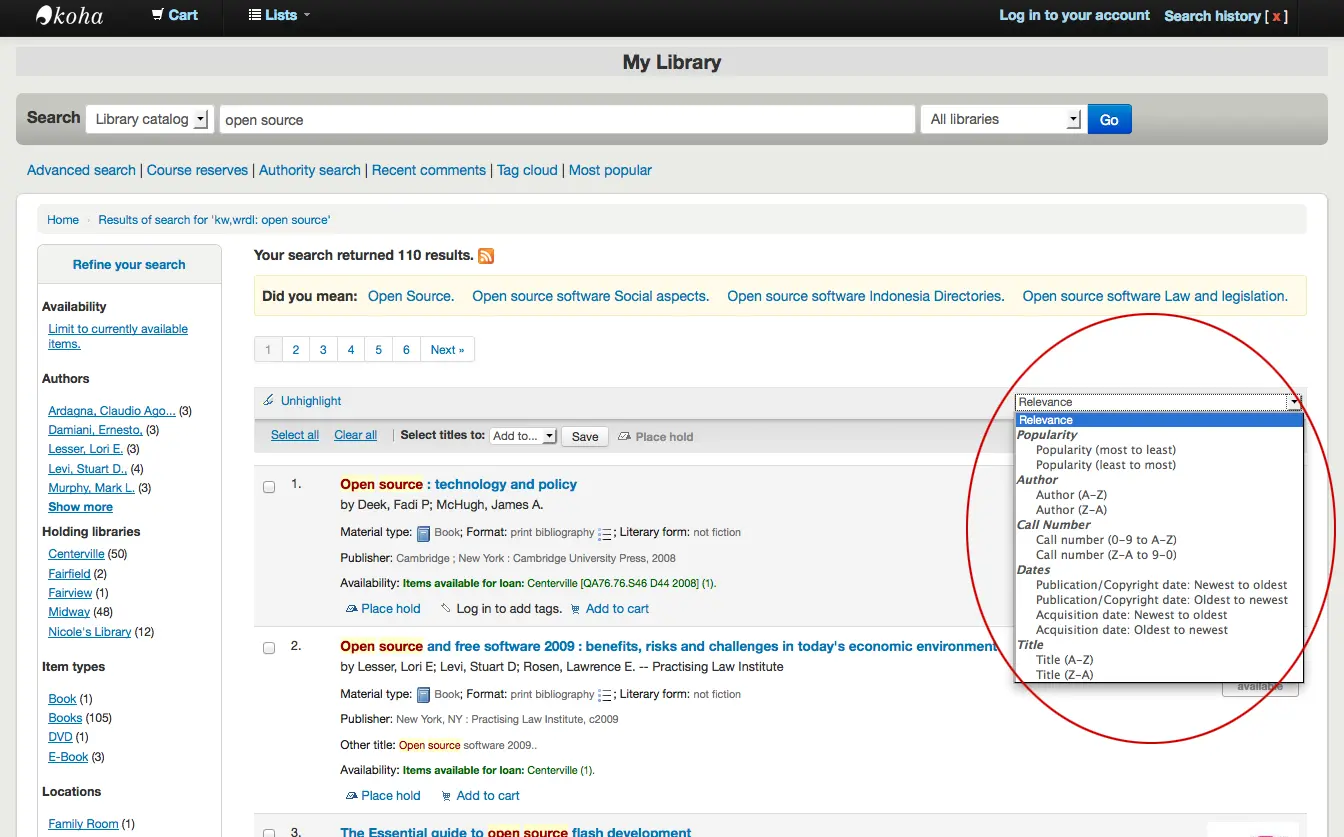
Under each title in the results list, there will be a series of values from the record’s leader (field 000).

Nota
These values have nothing to do with the item types or collection codes you have applied to your records or items. This data is all pulled from the record’s control fields.
This can be turned on or off with the DisplayOPACiconsXSLT system preference.
Below each title, there will be the availability for the items attached to the record.
Nota
Even if you filtered on one library location, all locations that hold the item will appear on the search results.
Avvertimento
An item’s hold status does not affect whether or not the item is “available” until the item is in “waiting” status. Items with on-shelf holds will show as available until a staff member has pulled them from the shelf and checked the item in make it show “waiting”.
If any enhanced content system preferences are turned on, there may be cover images next to the search results.
If Did you mean? options are set, there will be a yellow bar across the top of your results will other related searches.
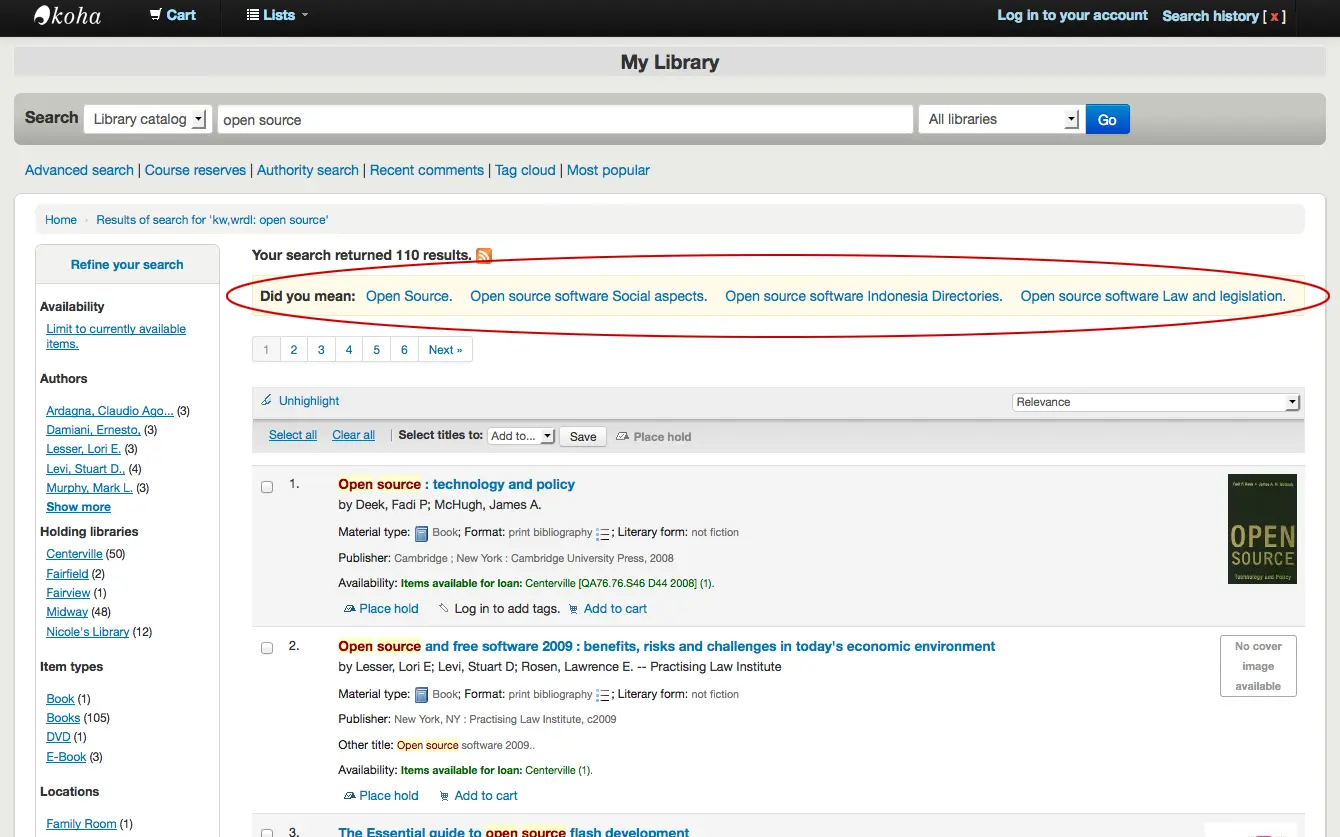
Se hai fatto una ricerca avanzata vedrai un’opzione per ritornare indietro a modificare la ricerca avanzata che hai fatto. Essa si trova sotto la lista della pagine dei risultati della ricerca.
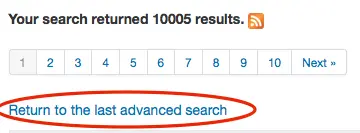
Filters (facets)
To filter your results click on the links below the “Refine your search” menu on the left of your screen.

Dopo aver cliccato su una faccetta, è possibile rimuovere il filtro dai risultati facendo clic sulla piccola “x” che appare a destra della faccetta stessa.
![Close-up view of the facets, in the author facets, "Shakespeare, William" is not longer a clickable link and has a [x] next to it](_images/removefilter.webp)
See the section on search results facets for more details on facets.
You can add custom content below the facets with the OPACResultsSidebar display location in the HTML customizations tool.
Cerca i feed RSS
Sarete in grado di iscriversi ai risultati della ricerca come un feed RSS facendo clic sull’icona RSS nella barra degli indirizzi o accanto al numero di risultati. Per saperne di più sui feed RSS si veda questo video tutorial.

Iscrivendosi ai risultati della ricerca come feed RSS, permetterà di vedere quando un nuovo record in una propria area di interesse si aggiunge al catalogo.
Record bibliografico
Quando si fa clic su un titolo dai risultati della ricerca, si apre il dettaglio bibliografico della registrazione. Questa pagina è suddivisa in aree.
Nella parte superiore della pagina ci sarà il titolo e la natura dell’opera [se DVD, raccolta, etc]:
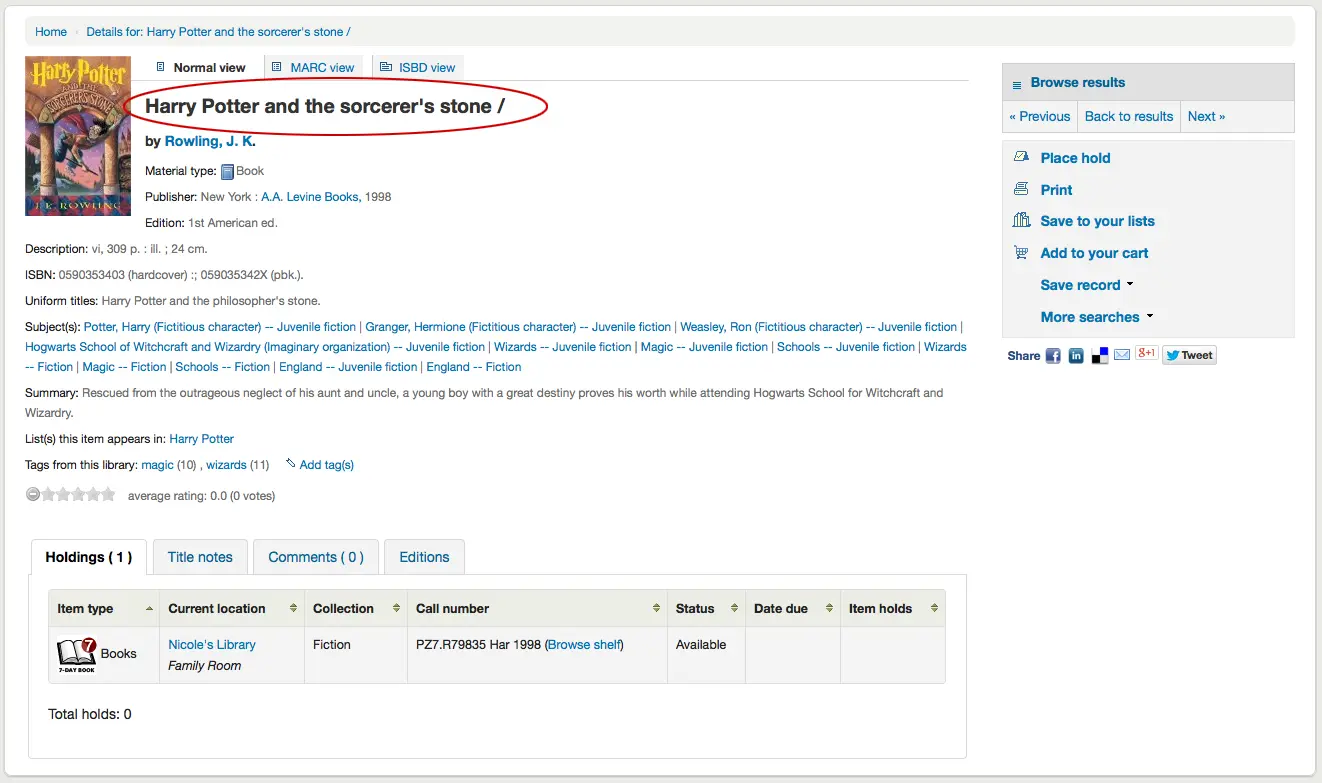
Sotto il titolo saranno elencati gli autori. Questi provengono dalle vostre 1xx e 7xx campi. Cliccando l’autore, parte una ricerca di altri titoli di quell’autore.
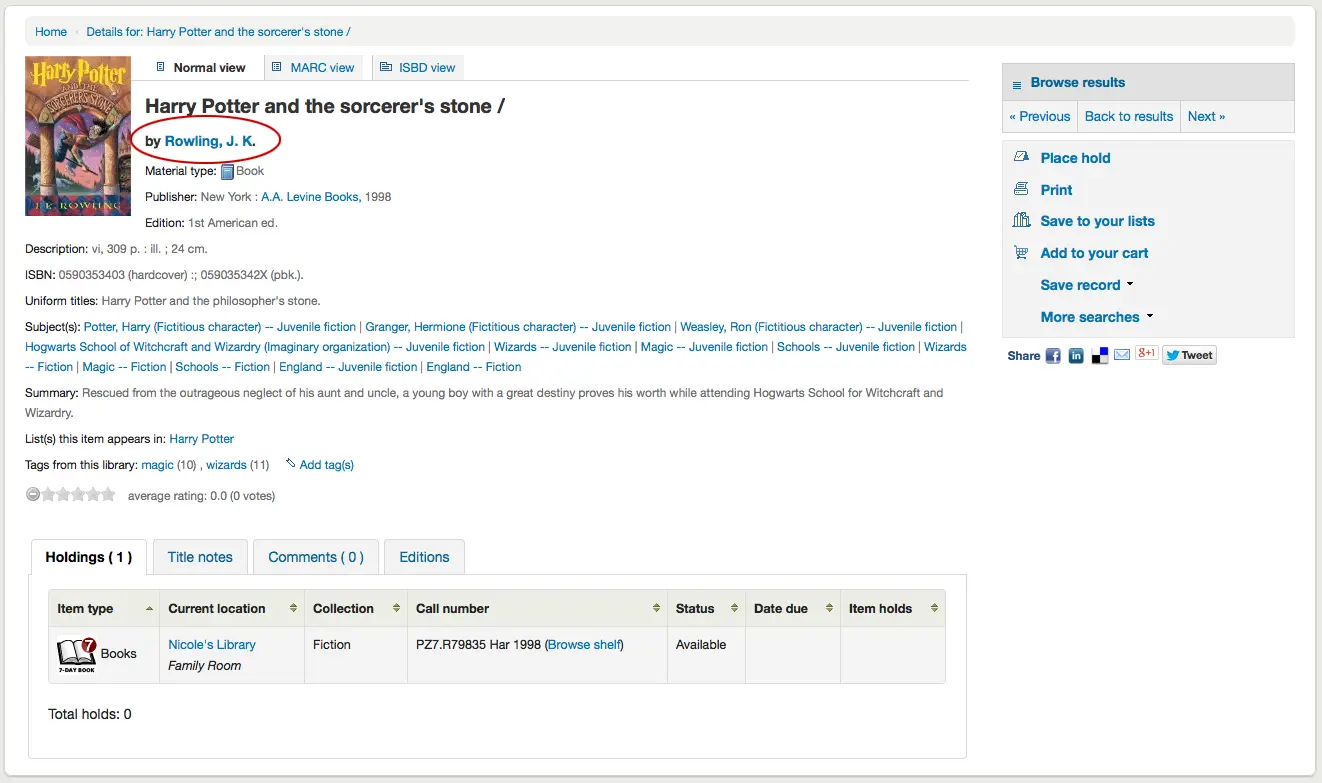
Se si dispone di un file di autorità verrà visualizzata una lente di ingrandimento a destra dell’autore e di altre intestazioni. Cliccando la lente d’ingrandimento si apre direttamente il record di autorità.
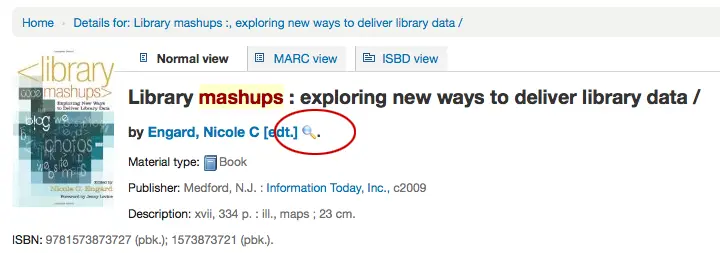
If you have your DisplayOPACiconsXSLT preference set to “show” you will see a material type that is determined by values in your fixed fields (learn more in the XSLT material type icons cataloging guide.
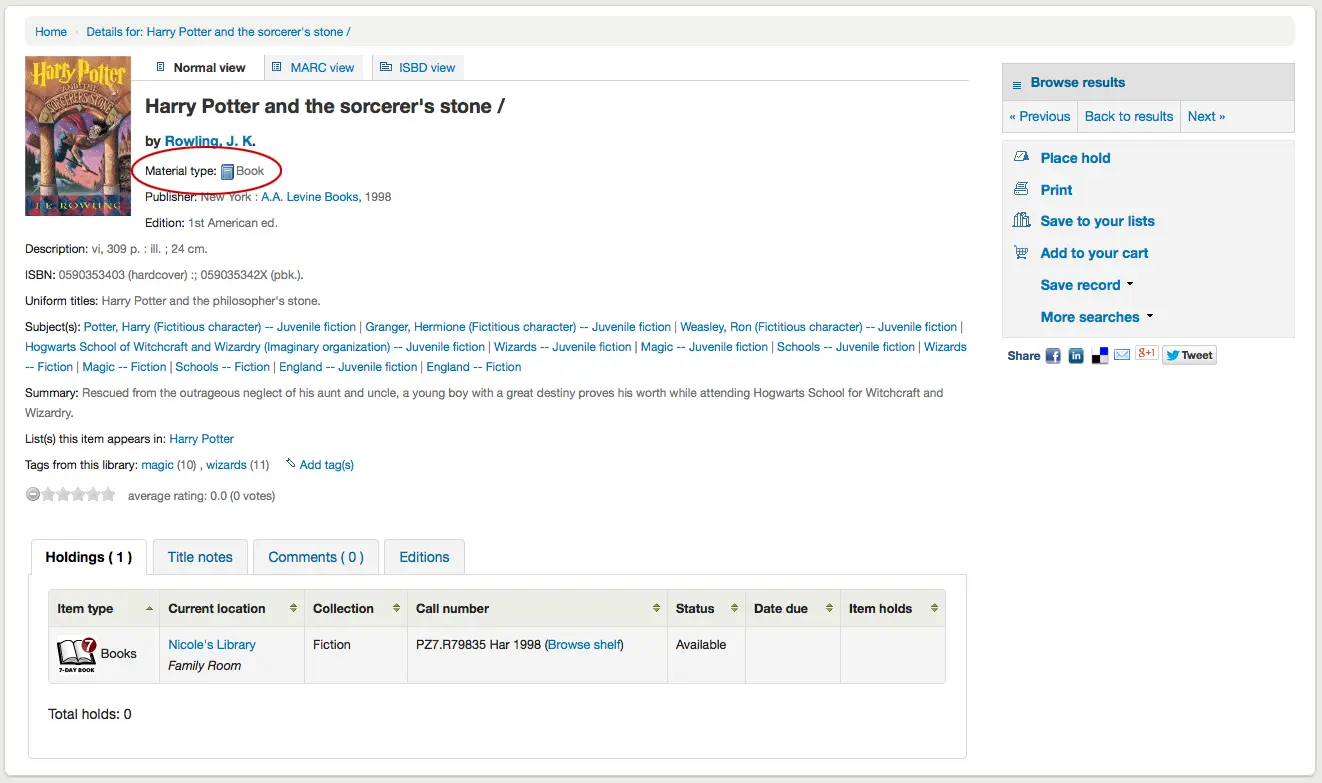
A continuazione vedrai la descrizione del record che stai visualizzando:
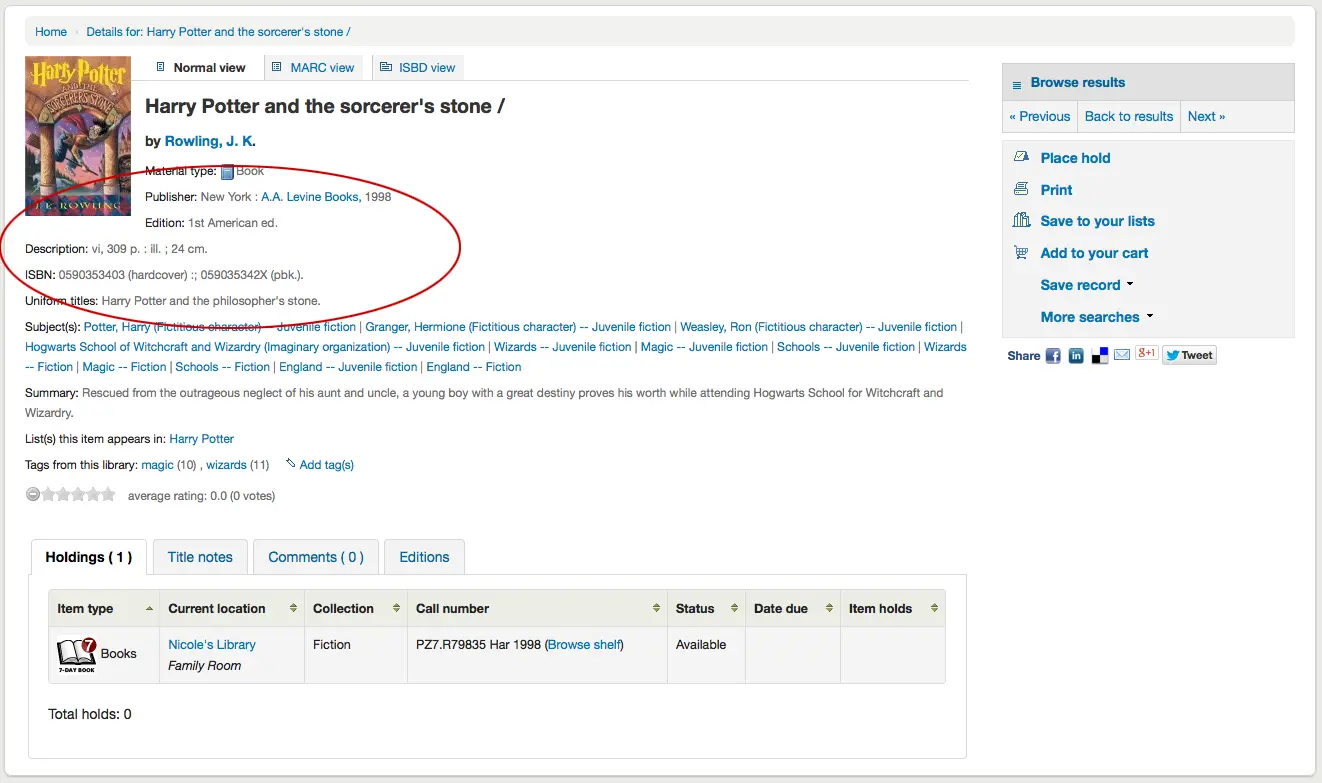
Dopo queste informazioni si trovano le intestazioni per soggetto, che può essere cliccato per la ricerca di altri titoli su argomenti simili
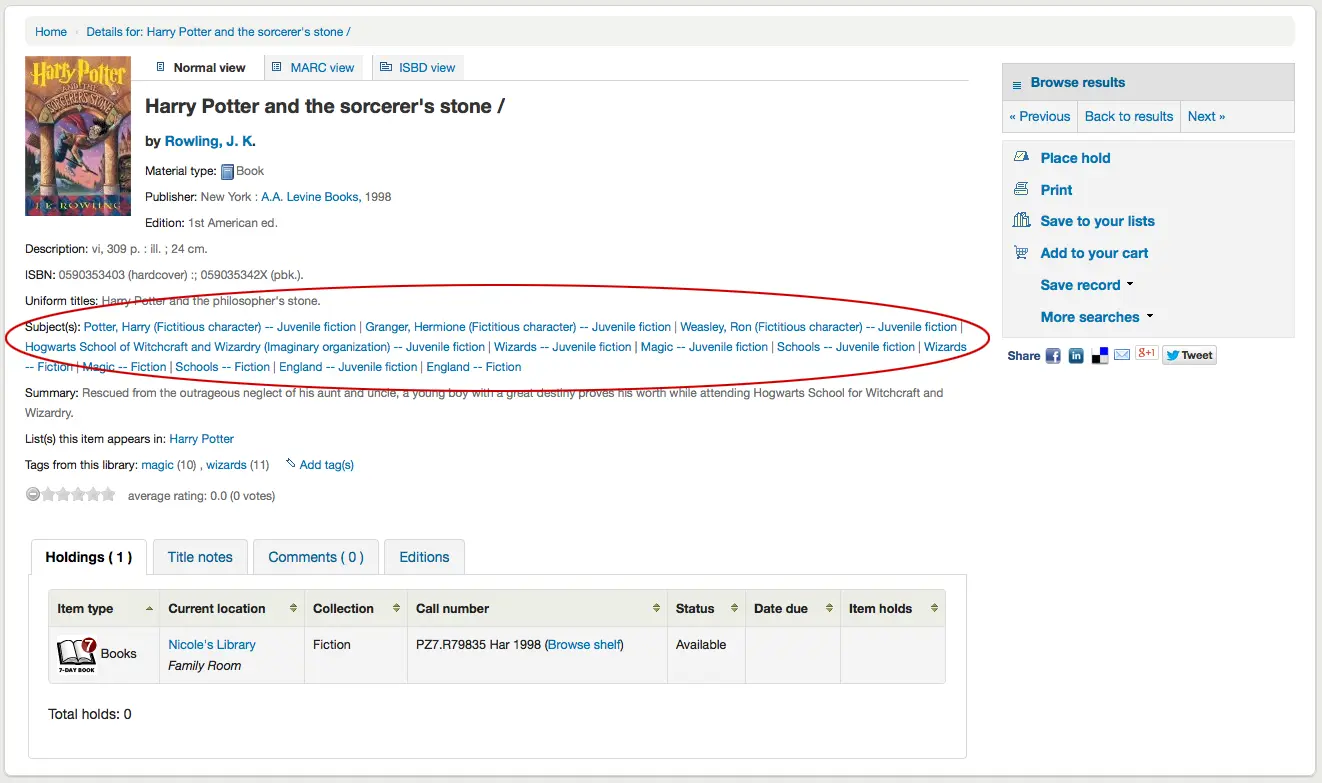
Se il record ha un indice o un o sommario esso apparirà accanto all’etichetta “Sommario” o “Indice”
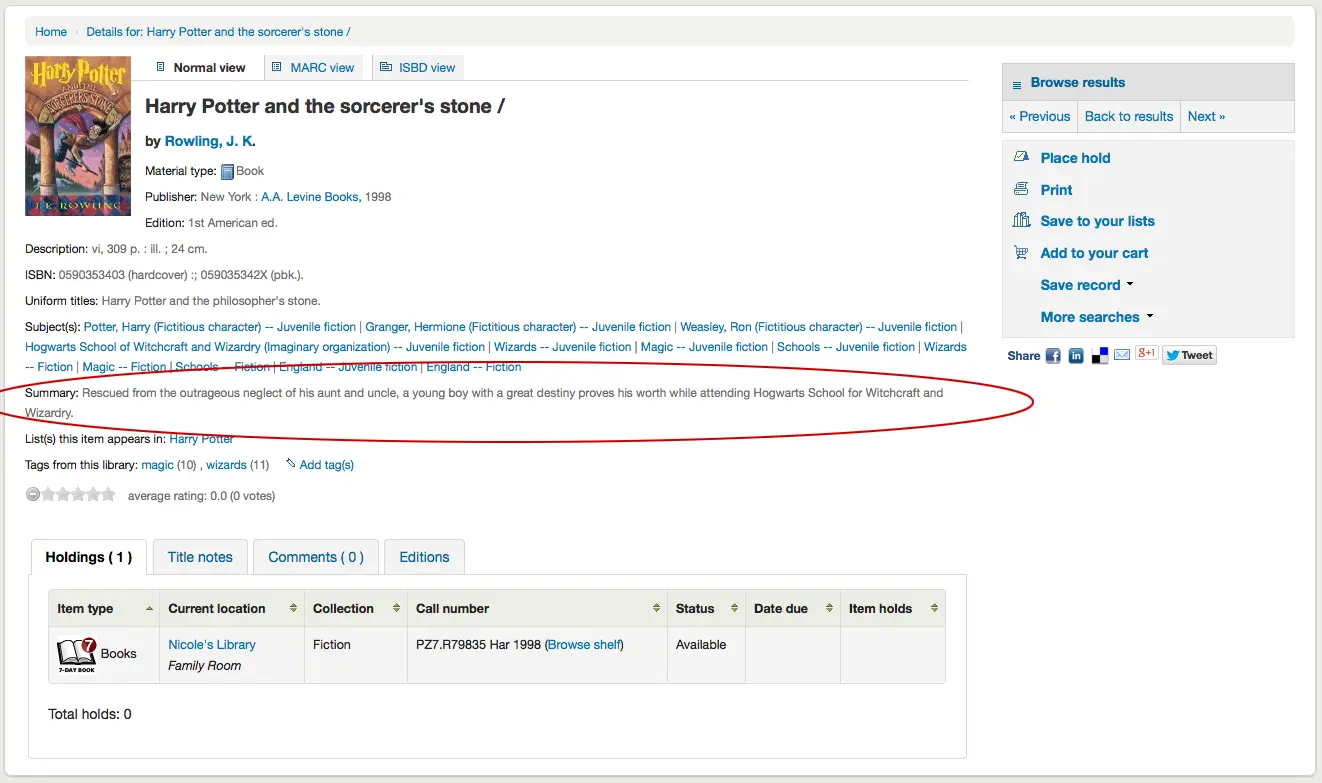
Se il record ha dati nei campi 856 vedrai i link a destra della etichetta “Risorse online”
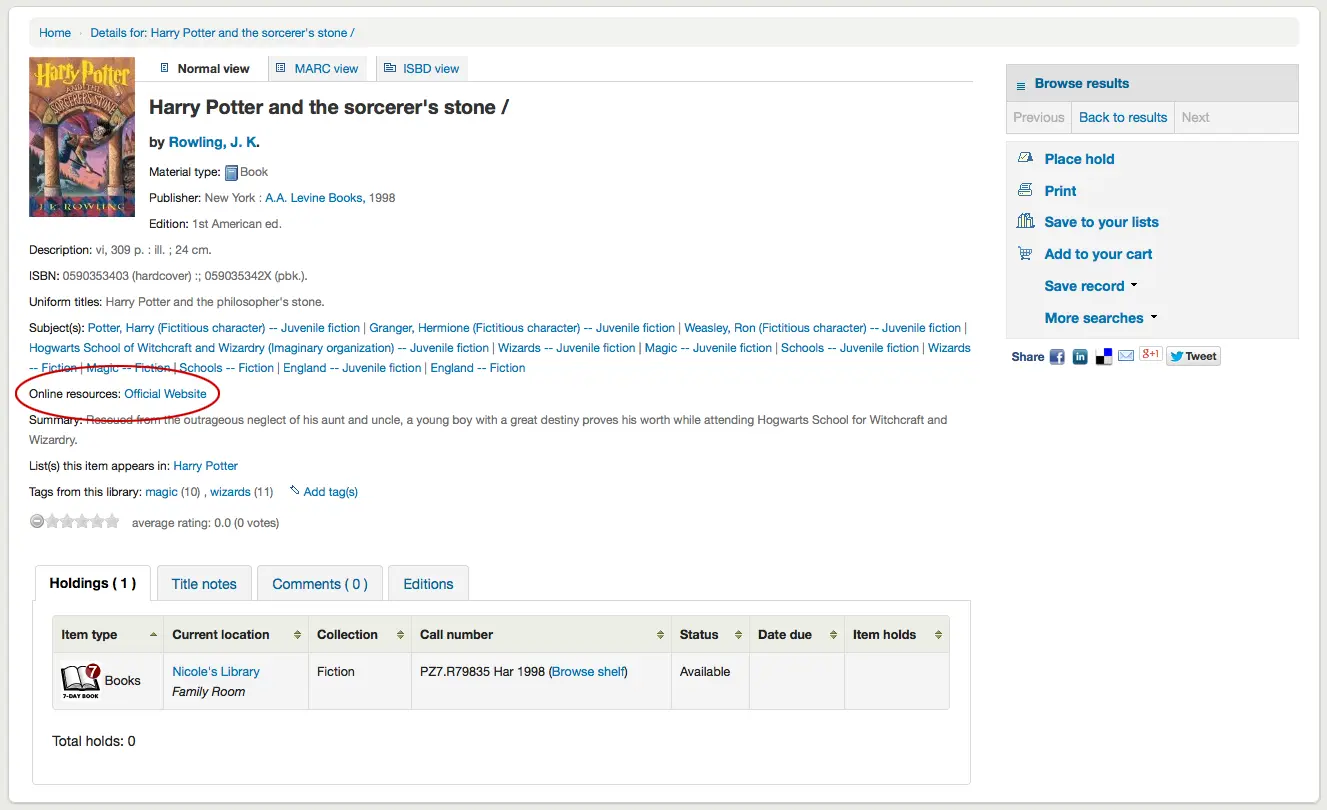
Se il titolo si sta visualizzando è in una lista pubblica, vedrai un elenco di quelli a destra della etichetta “Lista(e) in cui questo record appare” e se è stato taggato appariranno sotto l’etichetta «Tag da questa biblioteca”
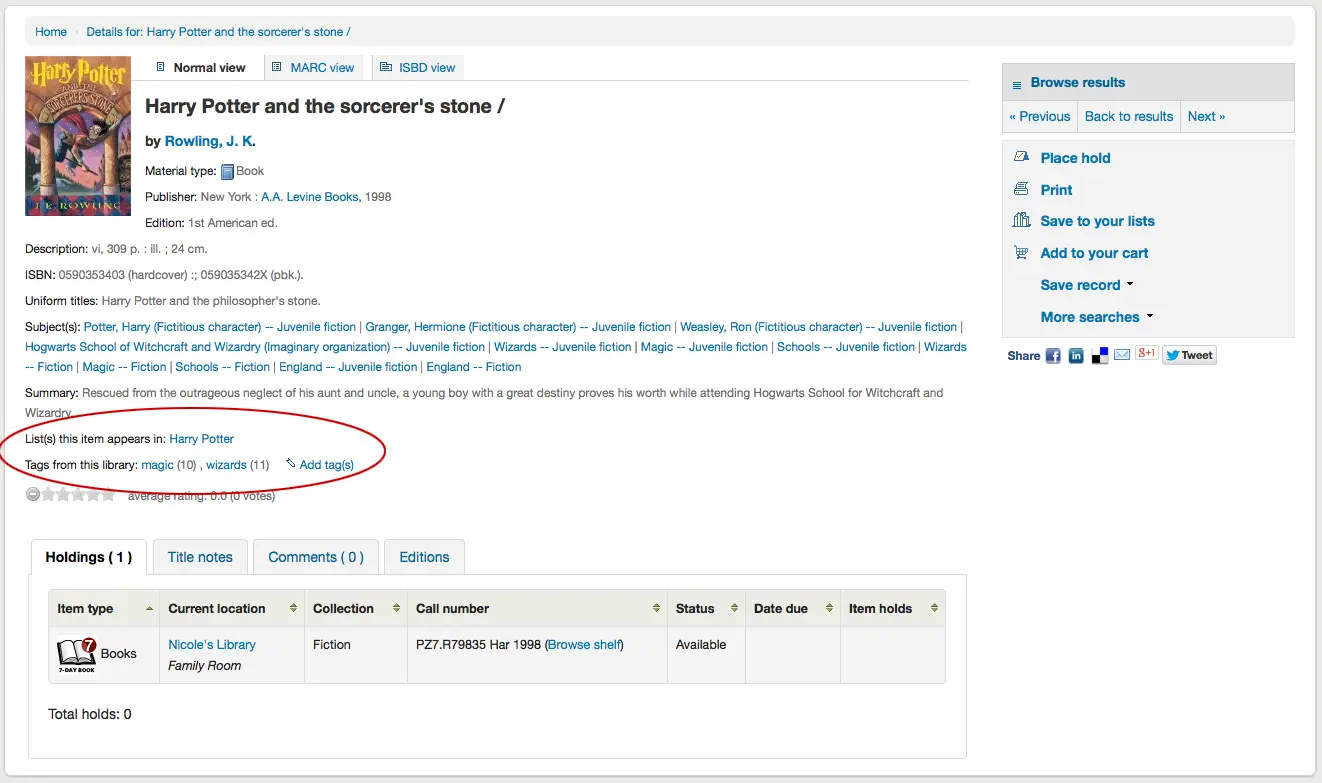
Nelle schede sotto i dettagli troverai i dati sul posseduto
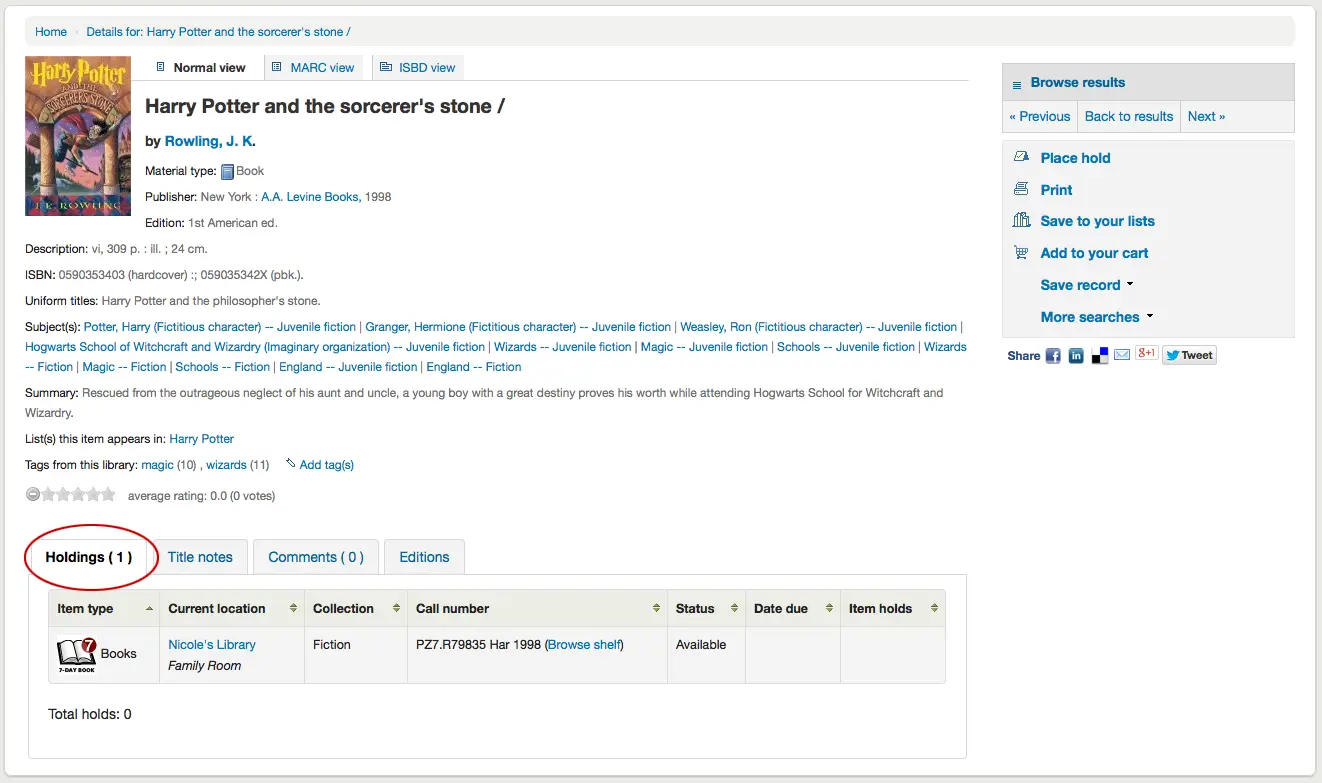
Nota
You can customize the columns of this table in the “Table settings” section of the Administration module (table id: holdingst).
Le note (campi 5xx del MARC21) appariranno sotto “Note”
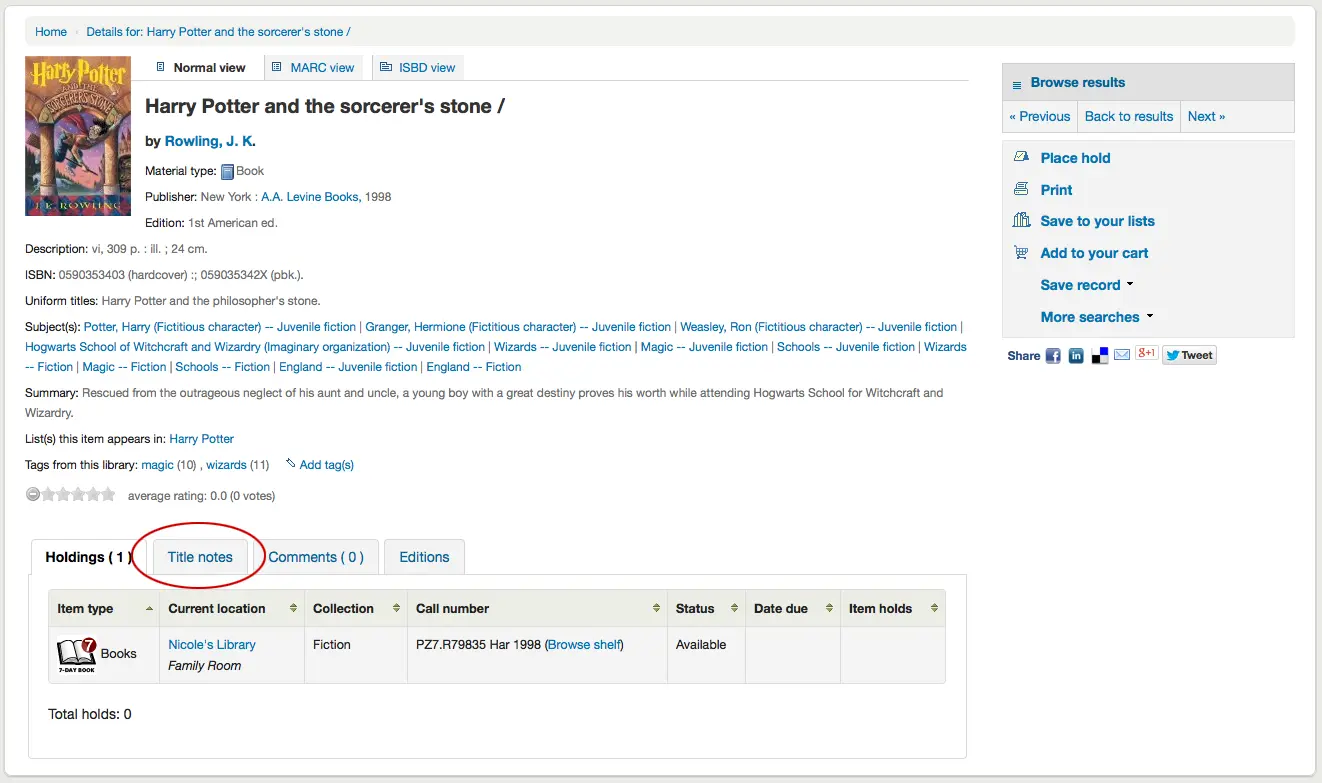
If the bibliographic record is linked to a subscription in the Serials module, there will be a “Subscriptions” tab with the subscription and issues information.

Nota
You can customize the columns of this table in the “Table settings” section of the Administration module (table id: subscriptionst).
Nota
If you chose a notice in the “Patron notification” field when adding the subscription, there will be a button patrons can click to be notified by email when a new issue is received.
Se i commenti sono attivi, appariranno nella scheda successiva
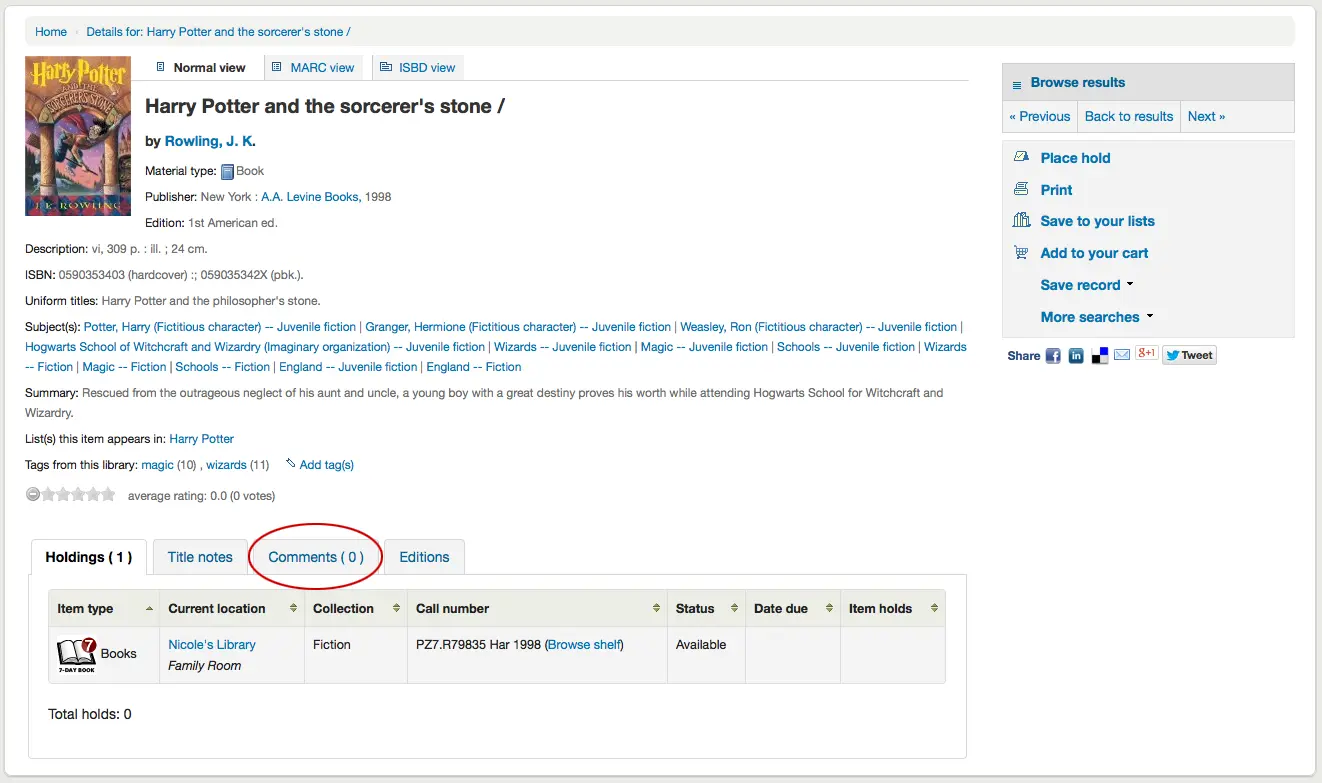
If the OPACAuthorIdentifiers system preference is turned on, and that your author authority records have standard identifiers, there will be an “Author identifiers” tab showing the identifiers with links to the author record on the source website.
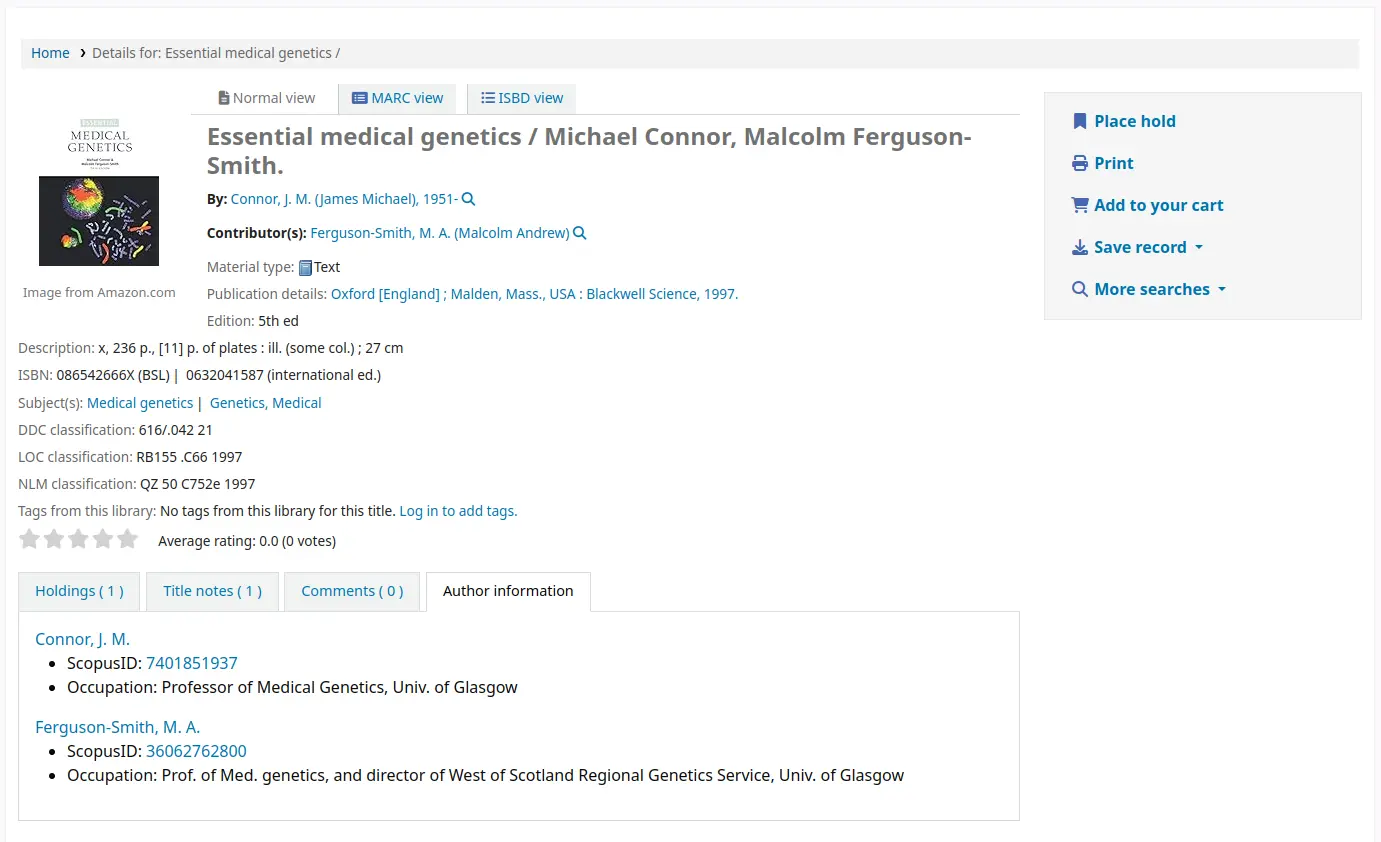
Infine, se FRBR è attivo e se in catalogo ci sono altre edizioni dello stesso titolo, vedrai la scheda “Edizioni”.
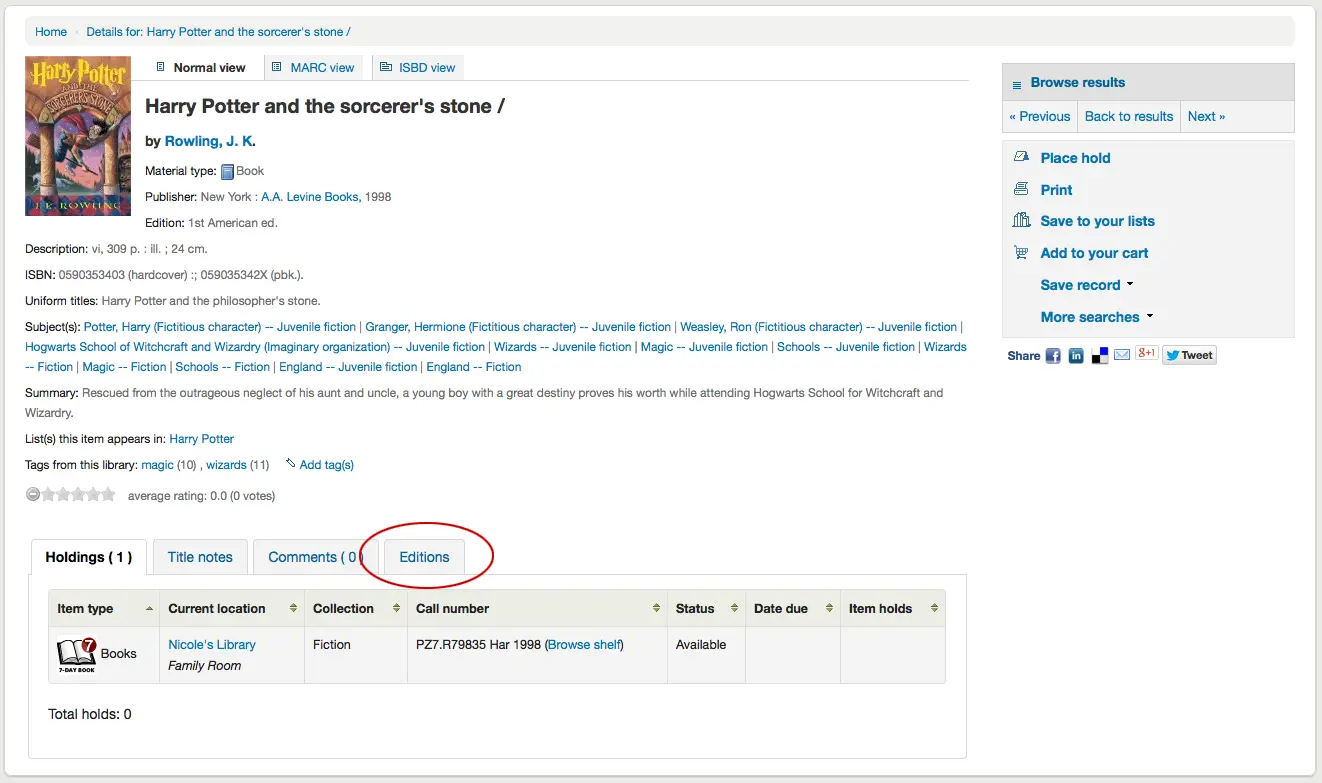
A destra dei dettagli troverete una serie di caselle. La prima casella è una lista di pulsanti per navigare i risultati di ricerca. Da lì si può vedere il risultato successivo o precedente dalla ricerca o tornare ai risultati.
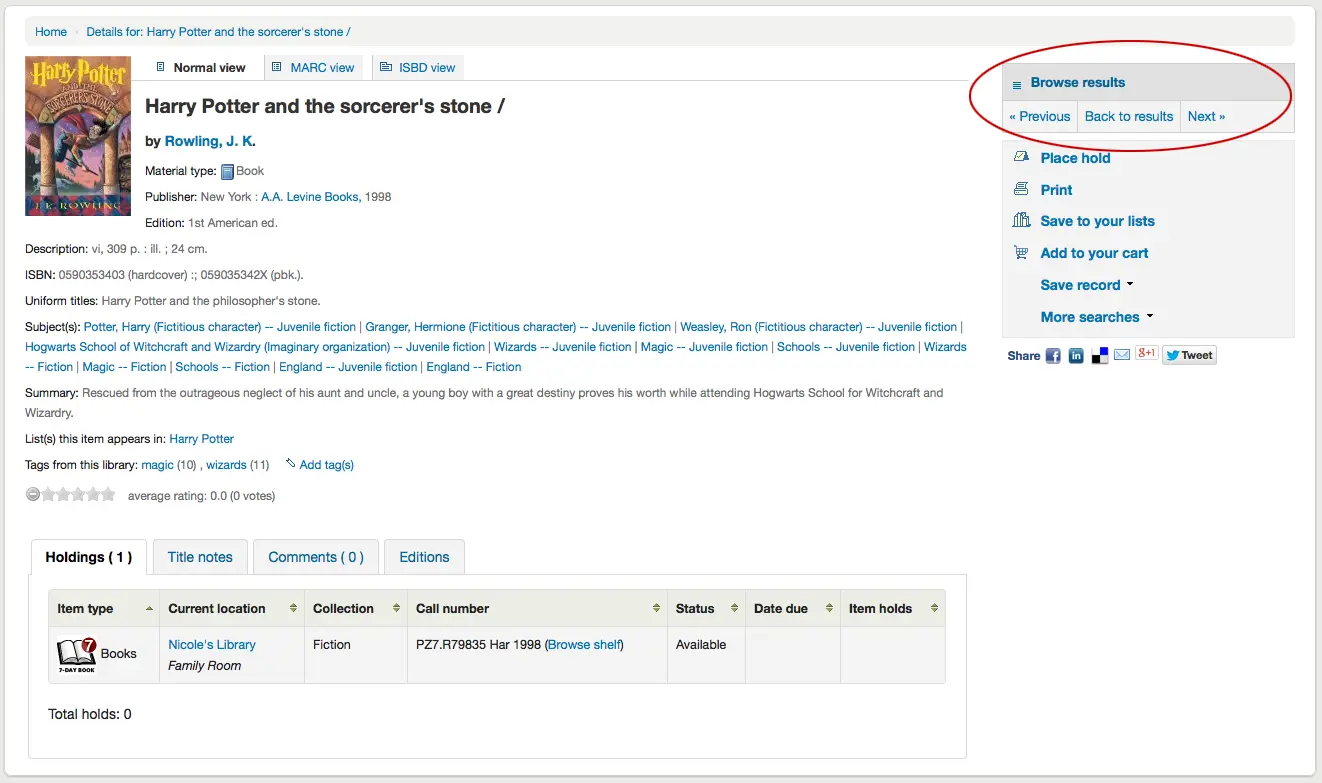
Facendo clic su Sfoglia tra i risultati nella parte superiore della colonna di destra aprirà i risultati della ricerca nella pagina di dettaglio
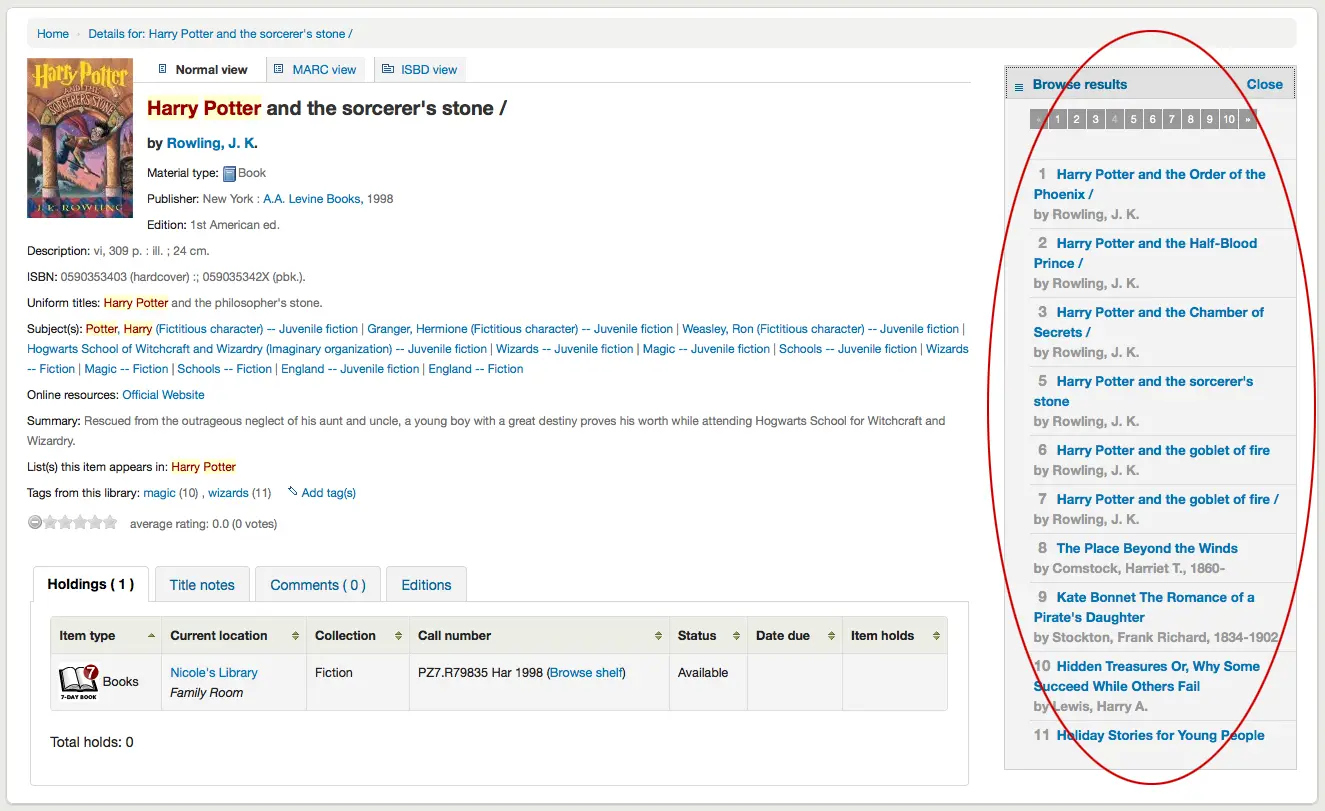
Sotto i bottoni di ricerca troverete i link per inserire una prenotazione, stampare il record, salvare il record in una lista, aggiungerlo al carrello o condividerlo (tramite QR code).
Another option that will appear on this right hand side bar, if a library is allowing purchase suggestions (see the suggestion system preference), is the ability to “Suggest for Purchase”. Clicking this link will bring the user to the purchase suggestion form to fill out.
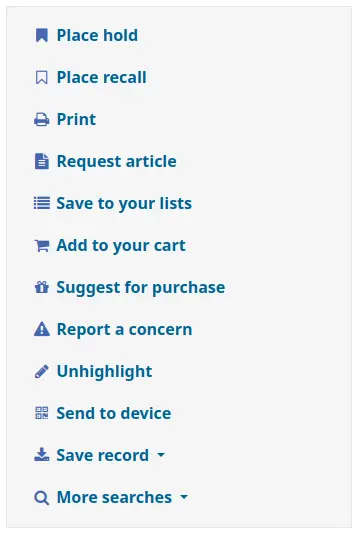
Clicking “More searches” will show the list of libraries you entered in your OPACSearchForTitleIn preference
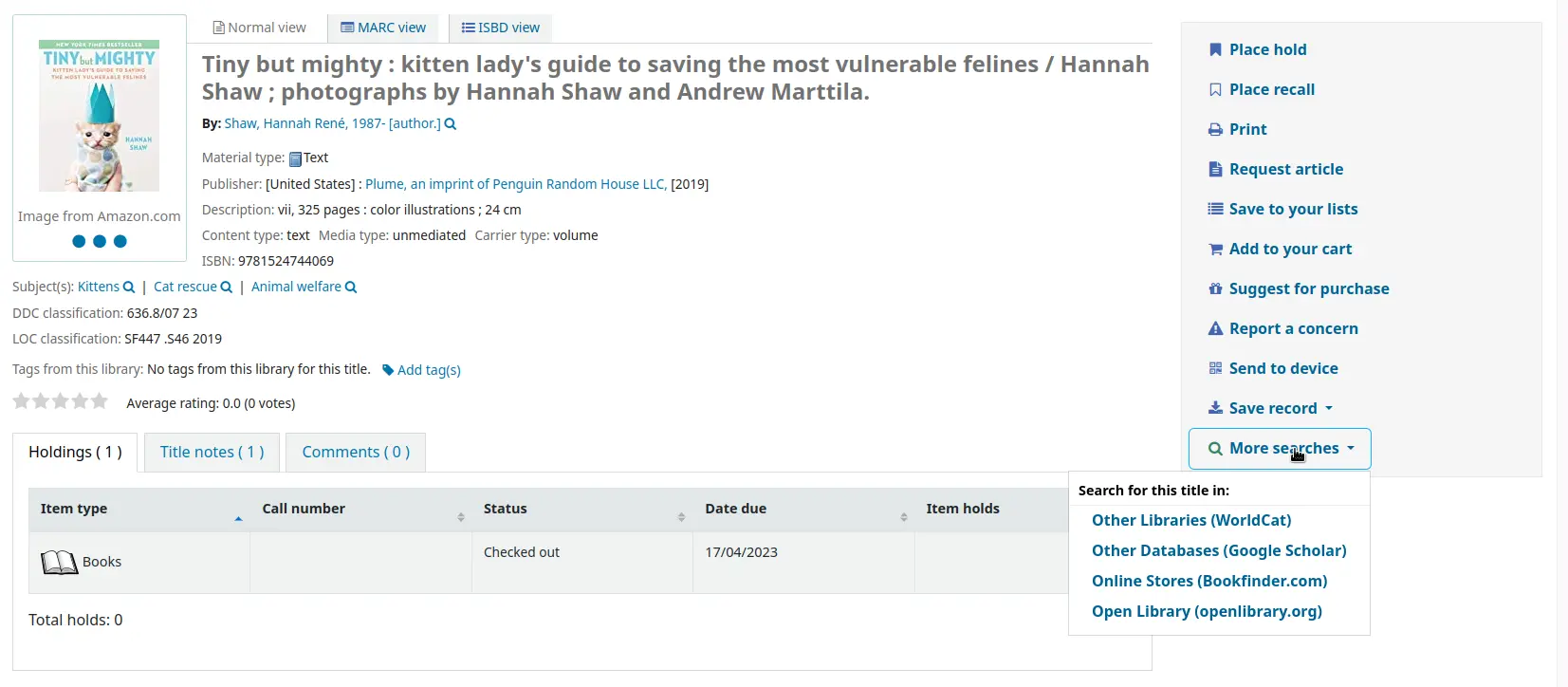
Under the “Save record” label you will find a series of file formats you can save the record as. This list can be customized by altering the OpacExportOptions system preference.
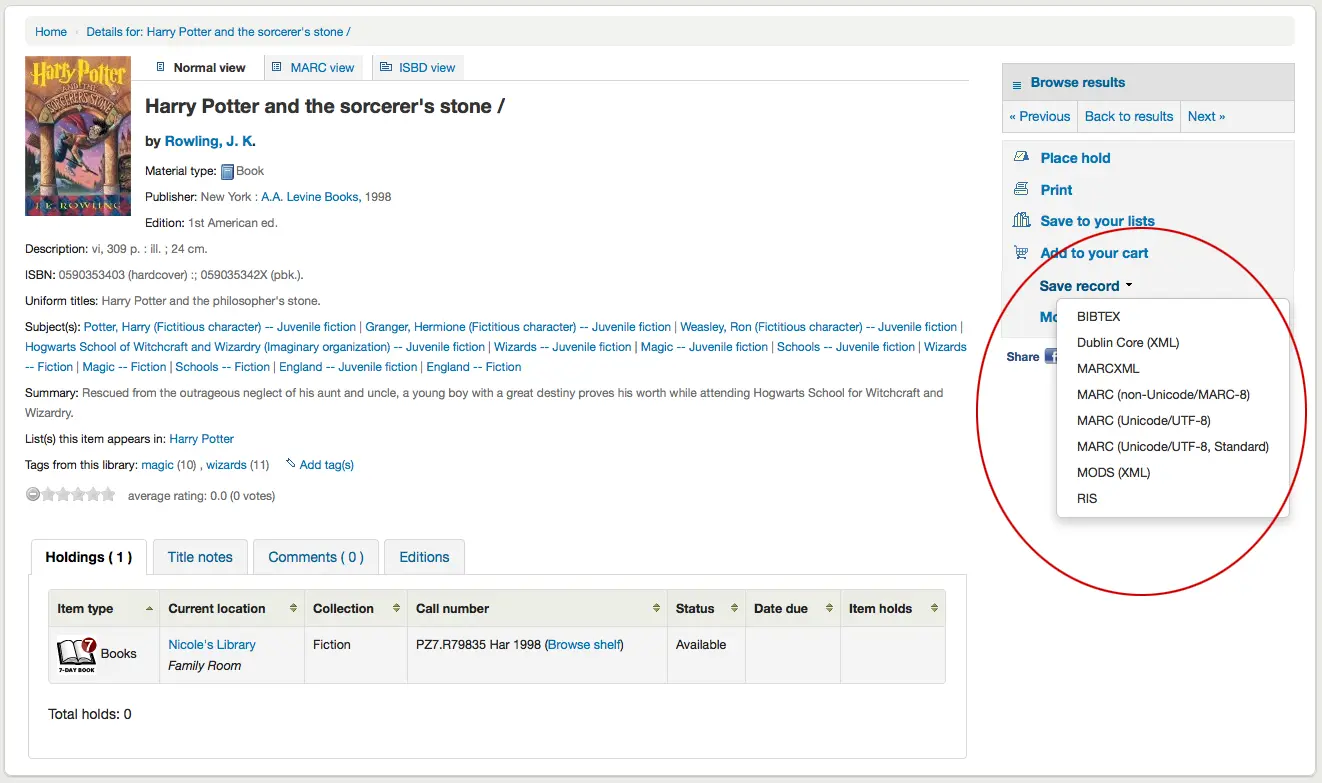
Se in qualsiasi momento si desidera modificare la vista da “Normale” e passare alle viste Marc o ISBD, è possibile fare clic sulle schede nella parte superiore del record
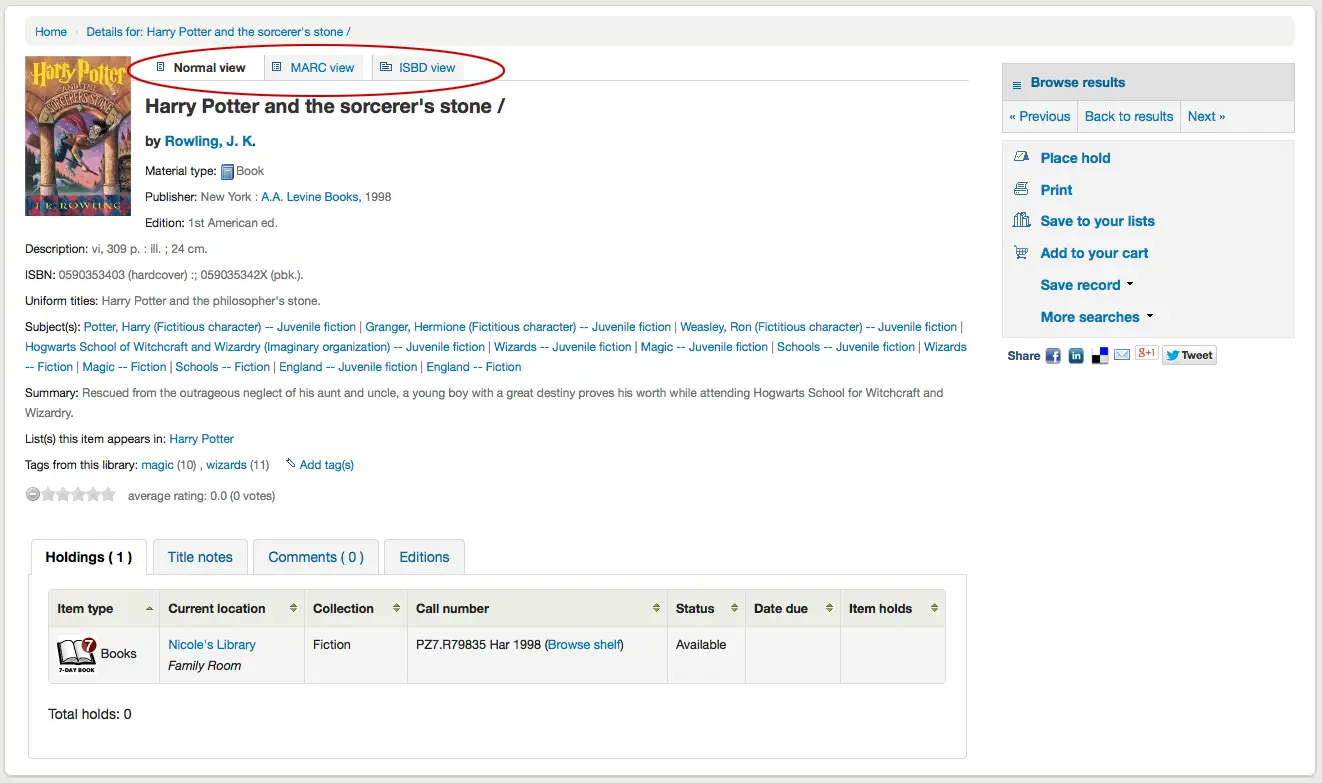
Reporting concerns about bibliographic records
If the OpacCatalogConcerns system preference is enabled, patrons will be able to report concerns regarding specific bibliographic records.
This is similar to the problem report feature but is linked to a specific bibliographic record, and there is the possibility to have a resolution.
To report a new concern,
In the bibliographic record’s detail page, click the “Report a concern” link in the options at the right side.

Nota
Patrons must be logged in to report a concern. If they are not logged in, the system will ask them for their login information.
Fill in the concern form.

Title: enter a title describing succinctly the problem.
Please describe your concern: enter details about the problem, being the more descriptive possible so that the staff member who receives this is able to replicate and see the problem.
An example of what is expected in the description is provided in the field:
**Describe the concern** A clear and concise description of what the concern is. **To Reproduce** Steps to reproduce the behavior: 1. Go to '...' 2. Click on '....' 3. Scroll down to '....' 4. See error **Expected behavior** A clear and concise description of what you expected to happen.
Nota
This text is customizable in the HTML customizations tool, by changing the “CatalogConcernTemplate” entry.
The text at the bottom of the form («Please describe your concern clearly…») is also customizable in the HTML customizations tool, by changing the “CatalogConcernHelp” entry.
Click “Submit”.
This will send an email to the cataloging team to notify them that a new concern has been created. The email will be sent to the email address in the CatalogerEmails system preference. The email sent is the TICKET_NOTIFY notice, which can be customized in the Notices and slips tool.
An email will also be sent to the reporter to notify them that the concern has been received. The email sent is the TICKET_ACKNOWLEDGE notice, which can be customized in the Notices and slips tool.
Concerns reported about this record are visible in the “Concerns” tab.

All concern tickets will be visible in the catalog concerns report.
Newly opened concern reports will also appear in the notification section at the bottom of the staff interface main page.

Liste & Carrello
A cart is a temporary holding place for records you’re interested in finding during this session. That means that once you log out of the OPAC or close the browser you lose the items in your cart.
A list is a more permanent location for saving items.
To learn more about lists, check the Lists and cart chapter of this manual, which deal with these features in the staff interface.
Liste
Patrons can manage their own private lists and find all public lists by visiting the “Lists” section of their account.
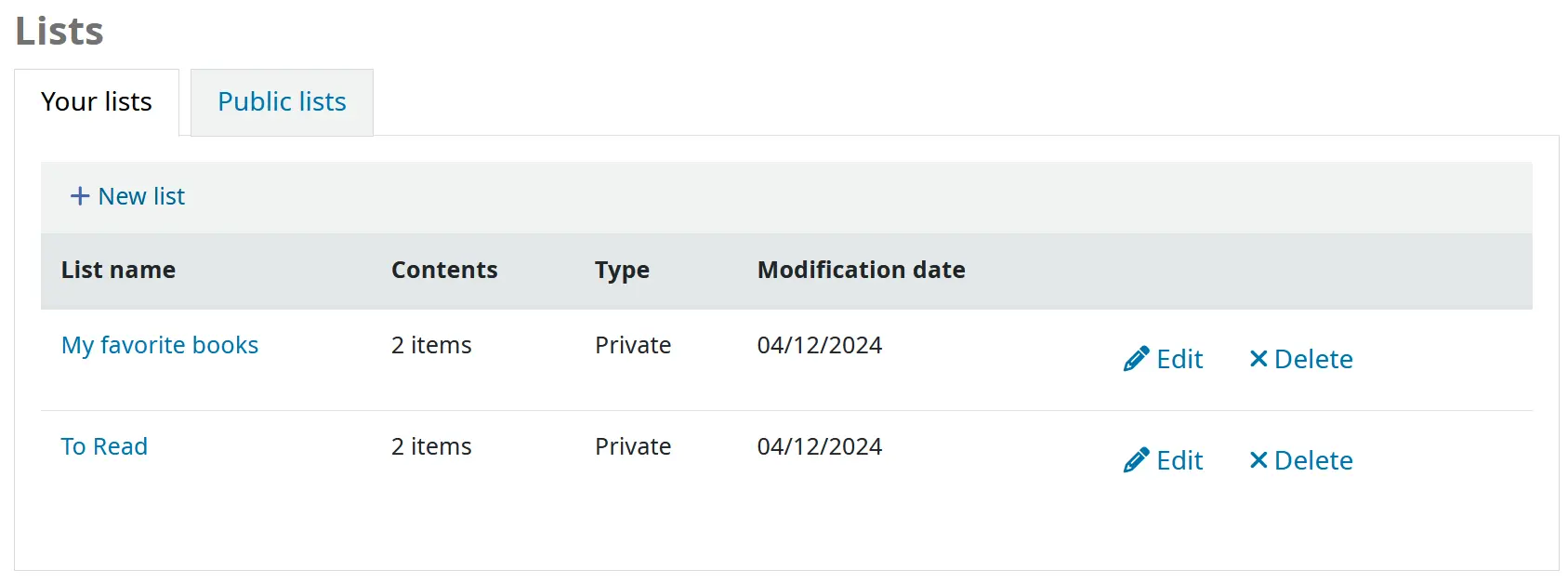
The “Modification date” column shows when the list was last modified and is helpful for quickly finding out how up to date the list is.
Creare una lista
To create a list the patron simply needs to click the “New list” link and populate the form that appears.

List name: the patron must enter a list name, it is the only required field
Sort this list by: the patron can choose how they want the list sorted (by title, author, publication year, call number or date added to the list).
Category: the patron can choose to keep this list private or make it public. A public list will be visible to all OPAC users.
Nota
This field will only appear if the OpacAllowPublicListCreation system preference is set to “Allow”. Otherwise all lists created by patrons will be private.
Allow changes to content from: the patron can choose who will be able to add or remove titles from the list.
Nobody: nobody, including the patron themselves will be able to add or remove titles.
Owner only: only the patron who created the list will be able to add or remove titles. If the list is public or shared, the OPAC users or sharers will not be able to change the list contents.
Anyone seeing this list: everyone who has access to the list will be able to add or remove titles. If the list is public, this means everyone. If the list is private, only the owner will have the ability to change the contents. And if the list is shared, the owner and sharers will have this ability.
Staff only: this option will only appear to staff members, to make the list editable by all staff members.
Le liste possono anche essere create scegliendo l’opzione “Nuova lista” nel menù “Aggiungi a” sui risultati della ricerca

Aggiungere titoli alle liste
Titles can be added to lists from the search results or from the bibliographic record.
In the search results, the option to add items to the list appear below each result (“Save to lists” button)

and across the top of the results page, next to “Select titles to: Add to…”

Per aggiungere un singolo titolo a una lista, fare clic sul “Salva in una lista” e scegliere la lista a cui aggiungere il titolo. Per aggiungere più titoli a una lista, selezionare le caselle sulla sinistra dei titoli che si desidera aggiungere e scegliere la lista a cui si desidera aggiungere i titoli dal menù a tendina “Aggiungi anche a” nella parte superiore dello schermo.
From the bibliographic record, the option to save the title to a list is in the menu on the right.
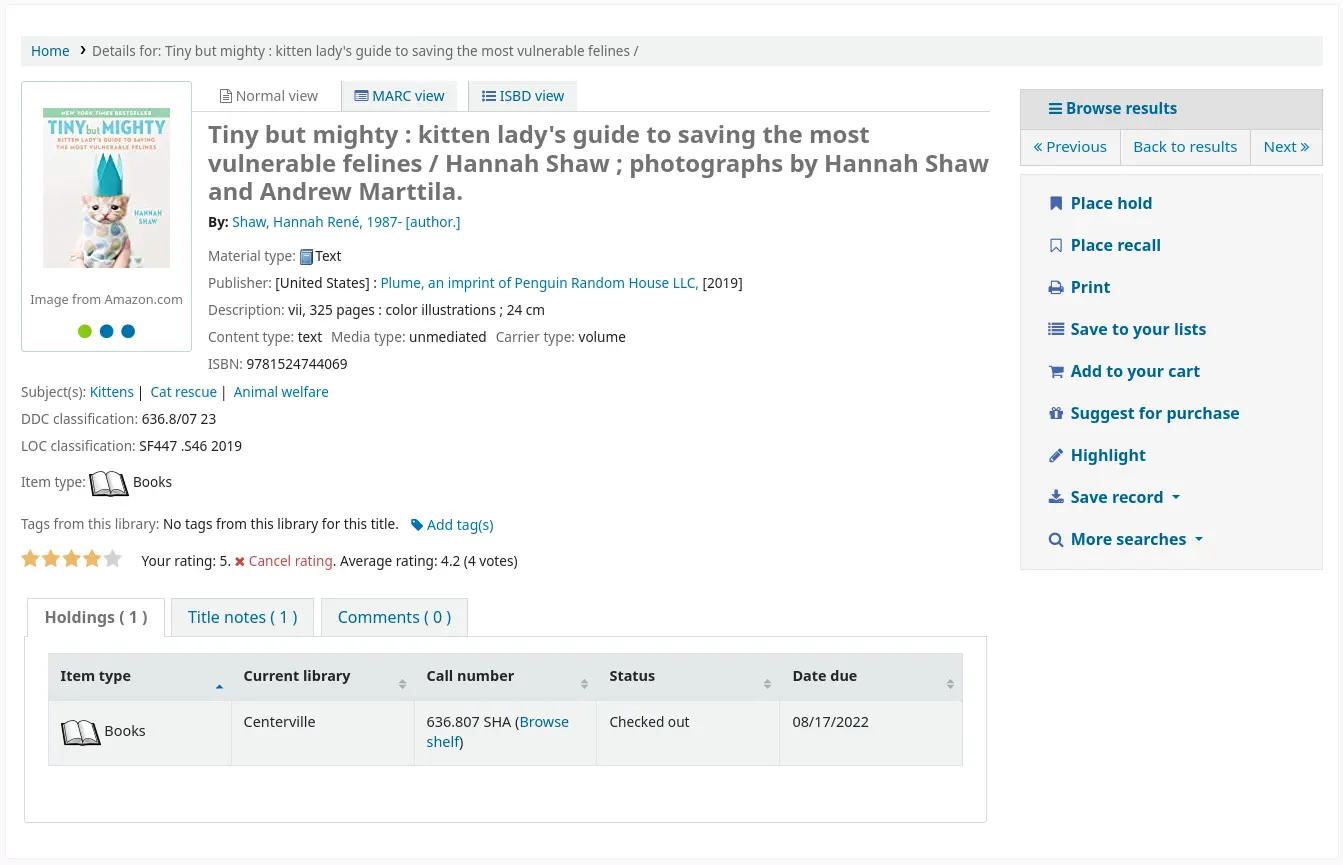
Titles can also be added to a list from the cart.
Visualizzazione del contenuto di una lista
Per visualizzare il contenuto di una lista, fare clic sul nome della lista sotto il pulsante Liste.
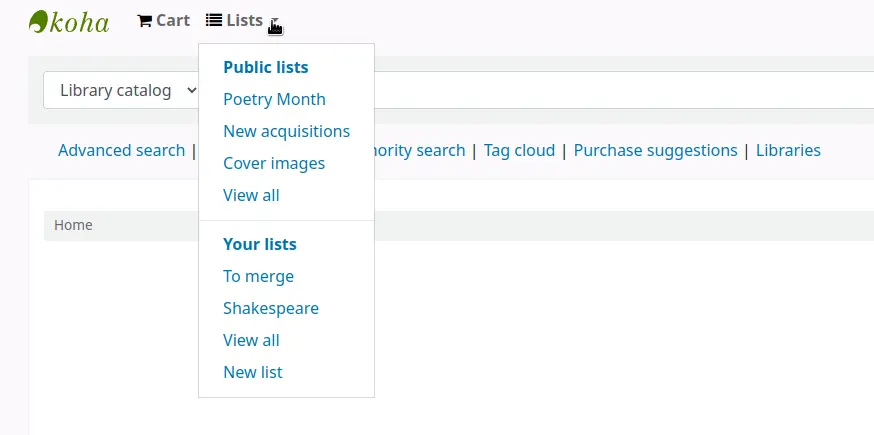
Il contenuto della lista sarà simile alle pagine dei risultati di ricerca, tranne che ci saranno diverse opzioni di menu nella parte superiore della lista.
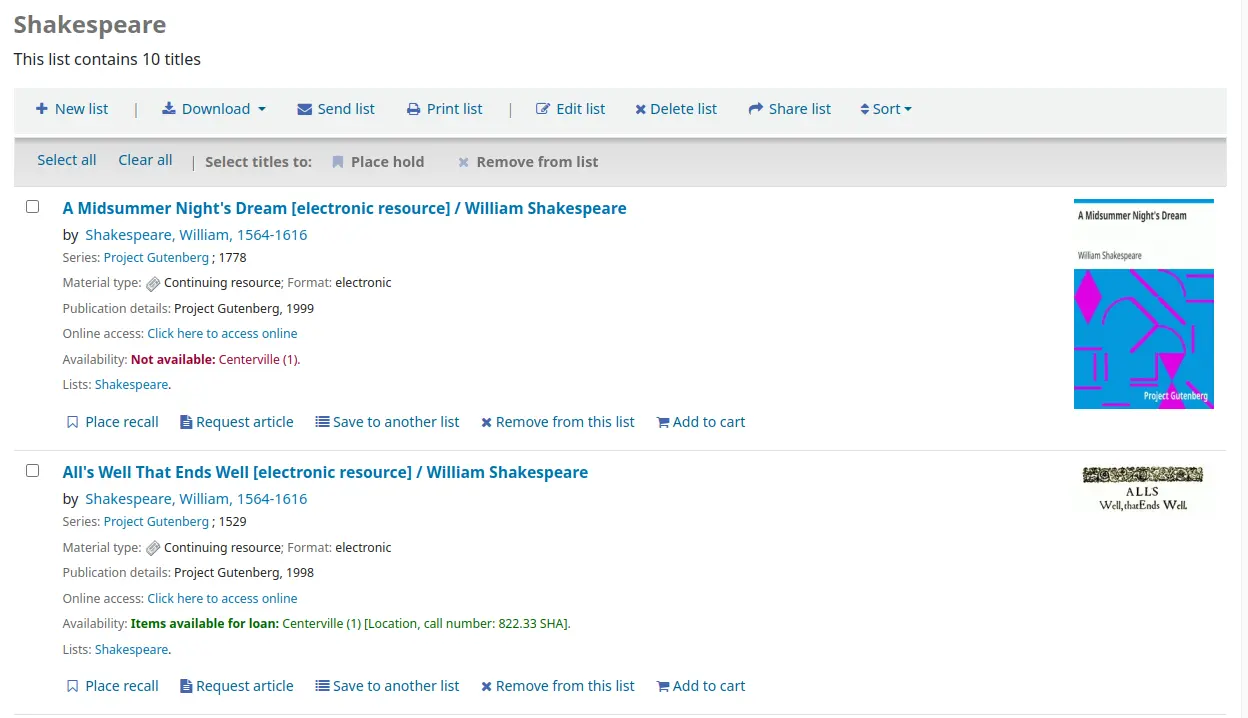
Sulla destra della lista titolo c’è una icona RSS che ti abilita a sottoscrivere gli aggiornamenti alla lista.
Nota
The RSS icon only appears on public lists.
Utilizzando le opzioni del menu sopra l’elenco è possibile prenotare più copie, scaricare il contenuto della lista, inviarla per e-mail o stamparla.
Per prenotare una o più copie nella lista selezionare la casella a sinistra della copia e fare clic sul link “Prenota” in alto
Per scaricare il contenuto della lista clicca sul collegamento “Scarica Lista” e scegliere il formato desiderato per scaricarla
Per inviare via e-mail il contenuto della lista a qualcuno, fare clic su “Invia Lista” link ed inserire i dati di posta elettronica nel modulo che si apre
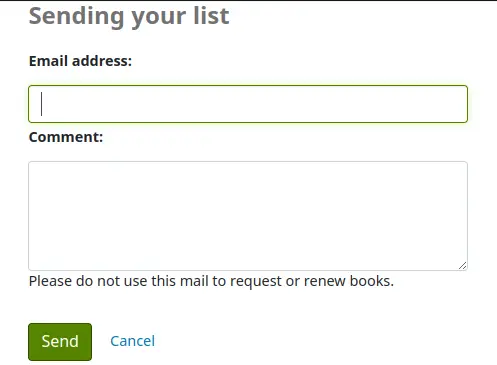
Nota
The message sent when emailing the list is LIST, which can be customized in the Notices and slips tool.
Nota
The “Send list” option will only appear if the OPACDisableSendList system preference is set to “Allow.”
Per stampare il contenuto della lista cliccare sul link “Stampa lista”
Removing titles from lists
To remove a title from a list,
-

Click “Remove from this list” under the title to remove.
Click “Yes, delete from list” to confirm the removal of the title from the list.
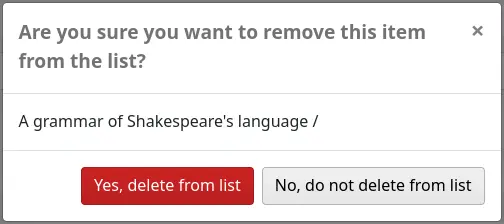
Gestione delle liste
Once the list is saved, patrons can begin adding items to it. From the “Lists” tab in their account, the patron can edit and delete the lists they have created by clicking the appropriate button to the right of the list name.

To edit the list’s title or sorting patrons click the “Edit” button to the right of the list description.

Quando si clicca “Elimina” accanto a una lista vi verrà chiesto di confermare che si desidera eliminarla.
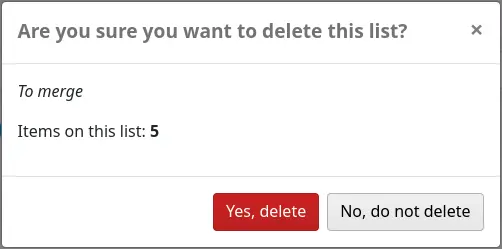
If the OpacAllowSharingPrivateLists system preference is set to “Allow”, patrons will see the “Share” button on the list of lists and the “Share list” button at the top of each individual list. Clicking this will ask you to enter the email address of a patron.

Una volta inserito l’indirizzo email, Koha presenterà un messaggio di conferma

e invierà un messaggio a quell’utente.
Once the other patron accepts the shared list, the sharing patron will receive a confirmation.
Nota
The message sent to share the list is SHARE_INVITE and the message sent to the sharing patron to confirm the other patron has accepted the share is SHARE_ACCEPT. Both messages are customizable in the Notices and slips tool.
The other patron will see the shared list with their own private lists (the type will be “Shared” rather than “Private”). They will also have the option to remove the share, if they don’t want to have access to this list anymore.
The owner of the shared list will have the option to transfer the ownership of the list to one of the patrons with whom the list is shared.
If the TagsInputOnDetail system preference is enabled, patrons will have the possibility of adding tags to titles from the list view.
Carrello
Aggiunta di titoli al carrello
Titles can be added to the cart from the search results or from the bibliographic record.
In the search results, the option to add items to the cart appear below each result (“Add to cart” button)

and across the top of the results page, next to “Select titles to: Add to…”

Clicking the “Add to cart” button under a single result will add the one title to your cart.
To add multiple titles at once, check the box to the left of each result and then choose “Cart” from the “Add to” pull down at the top of the screen. Once titles are added to the cart you will be presented with a confirmation at the top of the page.

Dai risultati si vedrà quali copie sono presenti nel carrello e si potranno rimuovere facendo clic su “(rimuovi)”.

From the bibliographic record, the option to add the title to the cart is in the menu on the right.

Gestione del carrello
Once there are titles in the cart, you can manage the contents by clicking on the “Cart” button usually found at the top of the screen. Your cart will open in a new window.
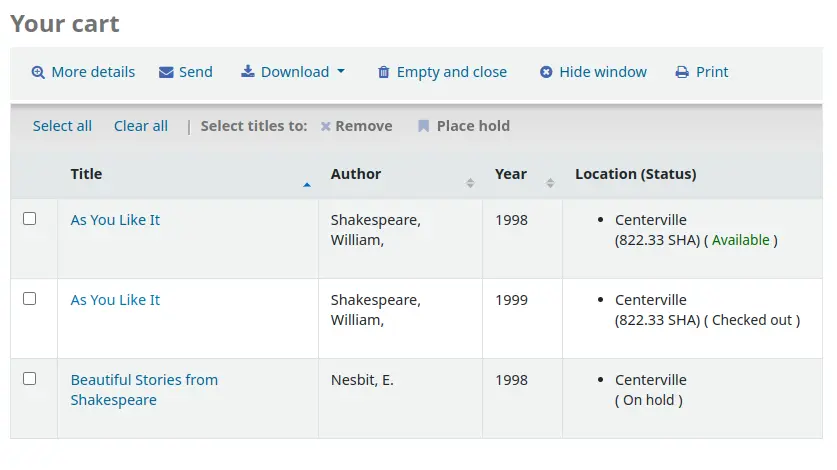
Da questa finestra vengono presentate diverse opzioni. Nella parte superiore del carrello ci sono alcuni pulsanti.
More details: clicking this will show additional information about the titles in the cart (ISBNs, subjects, publisher info, notes and more).
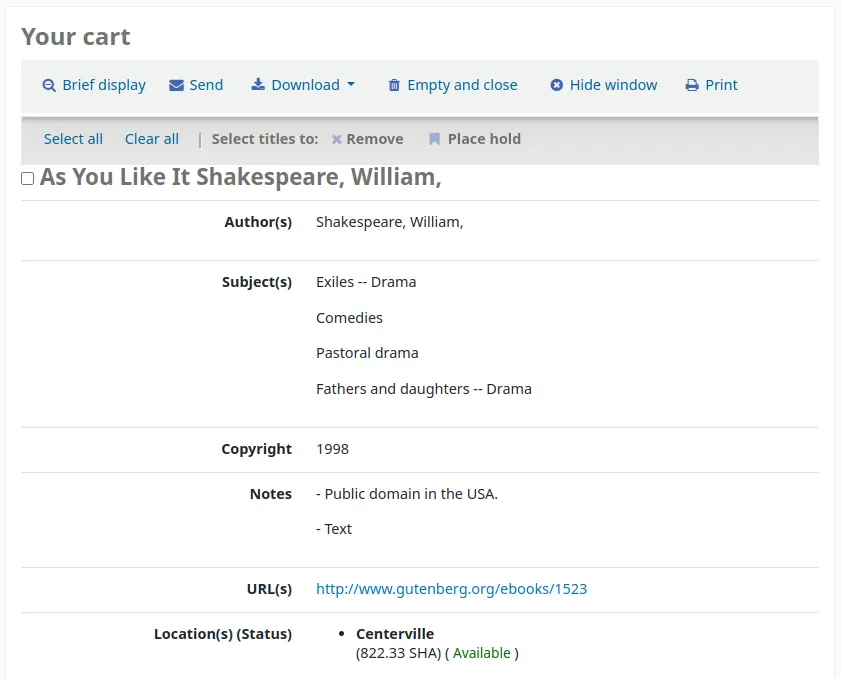
When clicked, the “More details” button will become “Brief display”. Clicking this will return to the default display in table form of the title, author, copyright date and item location and status.
Send: the option to send the contents of the cart to an email address. This is handy if you want to send the resources you found at the library to your home email account to refer to later or to send to a patron researching a specific topic. Clicking this link will open up a new window that asks for the email address and message to send.
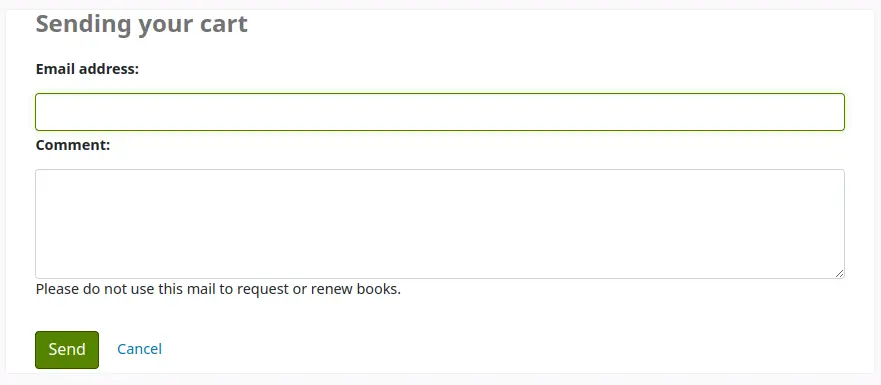
Avvertimento
The cart can only be emailed by logged in users. This will prevent the cart email function from being used for spamming.
Nota
The message sent when emailing the cart is CART, which can be customized in the Notices and slips tool.
Download: you can download the contents of the cart in several predefined formats or using a CSV profile that you defined in the tools module.
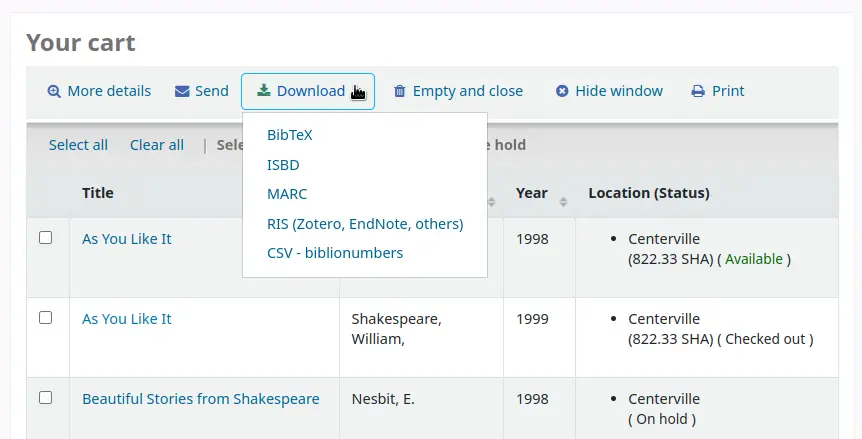
Empty and close: this will empty the cart and close the window.
Hide window: this will close the window, but the cart will not be emptied.
Print: this will print out the contents of the cart.
In addition to the various different ways to save the contents of the cart, there are ways to add value to the data in your cart.
Select one or more titles from the cart and choose one of the options:
Remove: this will remove the selected titles from the cart.
Add to a list: this will add the selected titles to a list
Place hold: this will place a hold on all selected titles
Tag: if the TagsInputOnDetail system preference is enabled, patrons will be able to add tags to selected titles.
Fare prenotazioni
Patrons can place holds on items via the OPAC if they’re logged in and the OPACHoldRequests system preference is set to “Allow”. If the item can be placed on hold, the option to place it on hold will appear in several different places.
If the DisplayMultiPlaceHold system preference is enabled, when viewing a list or search results page there will be the option to place hold on multiple items by checking the boxes to the left of the results and clicking “Place hold” at the top.

When viewing a list or search results page you’ll see the option to place the item on hold below the basic information about the title.

Durante la visualizzazione di un singolo titolo c’è la possibilità di inserire una prenotazione nella casella sul lato destro dello schermo

All of the above links will show the same hold screen.

The box to the left of the items to place on hold should be checked.
The title includes a link back to the detail page for the record.
Your priority: if the OPACShowHoldQueueDetails system preference is set to show the priority level, the priority, where in the holds queue this hold will fall, will be displayed.
Pickup location: if the OPACAllowUserToChooseBranch system preference is enabled, the patron can choose where they’d like to pick up their hold. The list of available pickup locations will include all libraries that have “Pickup location” set to “Yes” on the library configuration page.
Click “Show more options” to show additional settings for this hold.
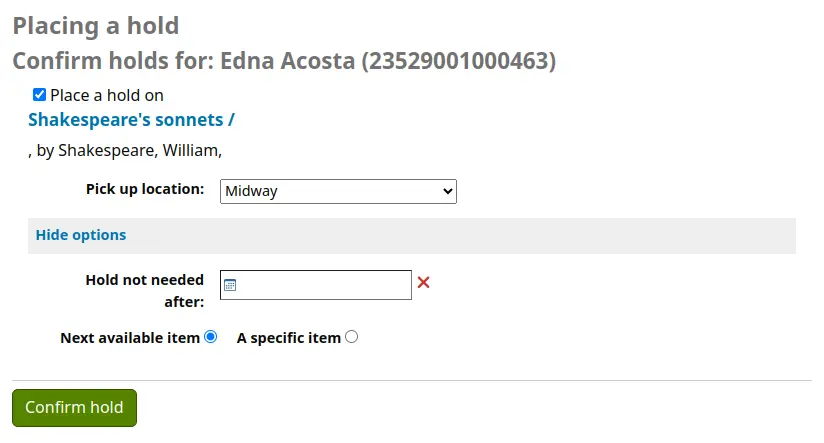
Hold starts on date: if the OPACAllowHoldDateInFuture system preference is enabled, this field will be displayed and it allows the patron to have their hold start on a future date.
Hold not needed after: by default, holds placed in the system remain until canceled, but if the patron fills in this field, the hold will have an expiration date.
Importante
Expired holds are removed by the cancel_expired_holds.pl cronjob. This is not an automatic process and must be set up by the system administrator.
Request specific item type: if the AllowHoldItemTypeSelection system preference is set to “Allow”, this option will be displayed for the patron to choose to limit the hold to a specific item type.
Request specific item group: if the EnableItemGroupHolds system preference is set to “Enable” and the record has item groups, the patron can choose to place a hold on the next available item of a group, rather than the next available item on the whole record or a specific item.
Hold notes: if the OpacHoldNotes system preference is enabled, patrons will be able to leave notes about their holds for the library.
Depending on the circulation rules regarding item-specific holds, the patron will be allowed to choose whether to place the hold on the next available item or a specific item.
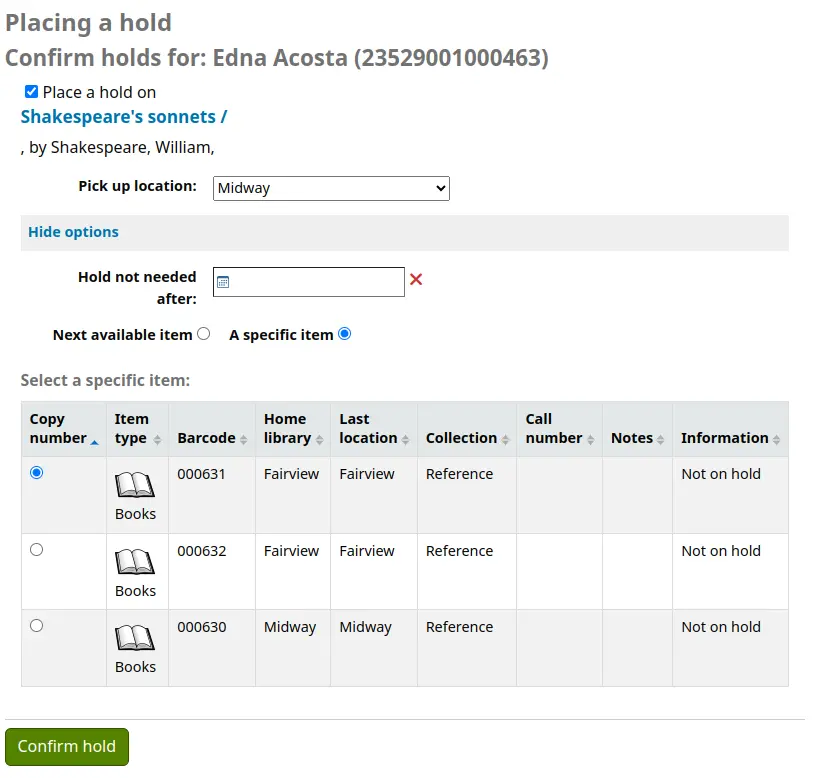
After clicking the “Confirm hold” button, the patron will be brought to their account page where they’ll see all of the items they have on hold.
Requesting recalls
If your library accepts recalls (see setting up recalls for more information), patrons will be able to place recalls on items.
The option to request a recall appears in various places in the OPAC:
In the results list after a search, the “Place recall” option appears at the bottom of each recallable result.

In the detailed record. the “Place recall” option appears on the right side of the screen (or bottom in mobile view) in the options

Either of those links will lead to the recall form.

Pick up location: the patron can choose where they’d like to pick up their recalled item.
Recall not needed after: if the patron not need this item after a certain date, they can enter it here. The recall will be automatically expired (with the expire_recalls.pl cronjob) after that date.
Recall next available item or Recall a specific item: the patron can choose to recall any item or a specific one. If they choose “Recall a specific item”, they will be asked to select the item in the list.
Once the patron confirms their recall request, they will have get a message saying the the patron who currently has the item will be notified.
Nota
The notice sent to the patron who currently has the item is RETURN_RECALLED_ITEM. It can be edited in the Notices and slips tool.
The request will be added to the recalls tab in their account summary, as well as in their recall history list.
Contenuto arricchito
OverDrive
If the OverDrive system preferences are used, an OPAC search will also search the library’s OverDrive collection.
After conducting a search, you will see a hyperlink above the library catalogue results: “Found X results in the library’s OverDrive collection”.
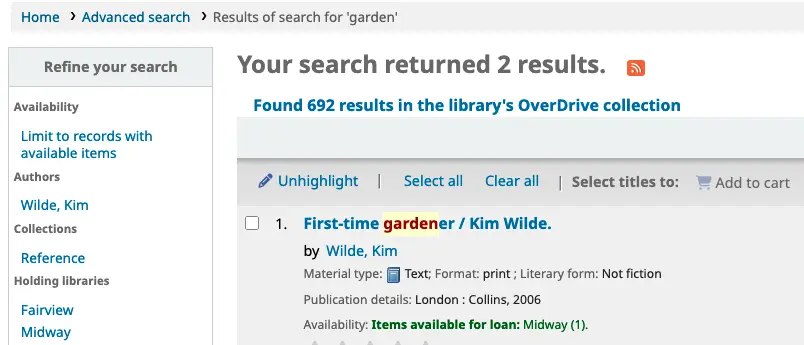
When you click on this link, you will see all the corresponding OverDrive results without navigating away from the OPAC.
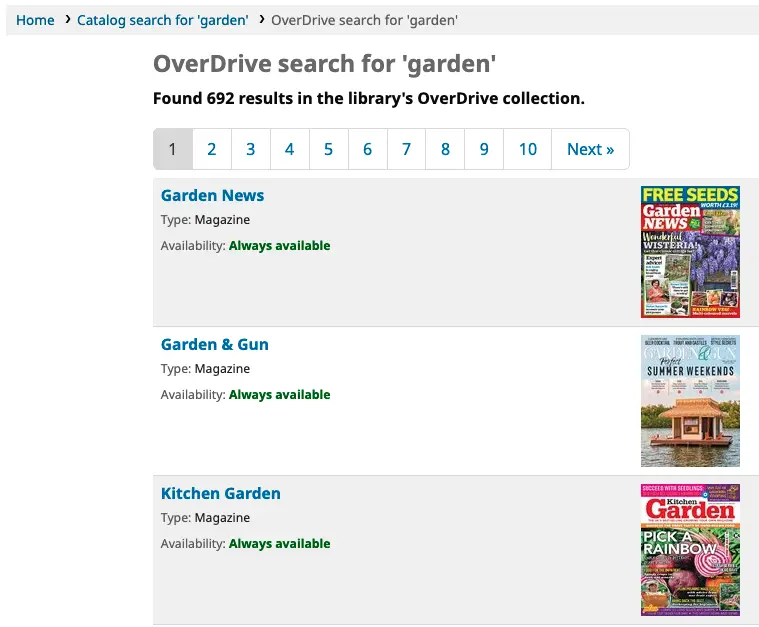
Clicking on a title in this list will take you to the record on the OverDrive website.
Marcatura
Depending on the settings for the TagsEnabled, TagsInputOnList and TagsInputOnDetail system preferences, patrons may be able to add tags to bibliographic records from the search results and/or from the bibliographic records” detail page.
If you are allowing patrons to add tags from the search results list (see TagsInputOnDetail), patron will see an “Add tag” button below each result and a “Tag” option at the top of the screen.

To add a tag to one item, click “Add tag”, type the tag or tags (separated by commas) in the “New tag” box and click “Add”. You will be presented with a confirmation of your tags being added.

Dai risultati puoi anche assegnare tag a oggetti in blocco cliccando le caselle di controllo a sinistra e facendo clic sul pulsante “Tag” nella parte superiore. Dopo averlo cliccato, il pulsante cambierà in una casella di testo per aggiungere tag a tutte le copie selezionate.
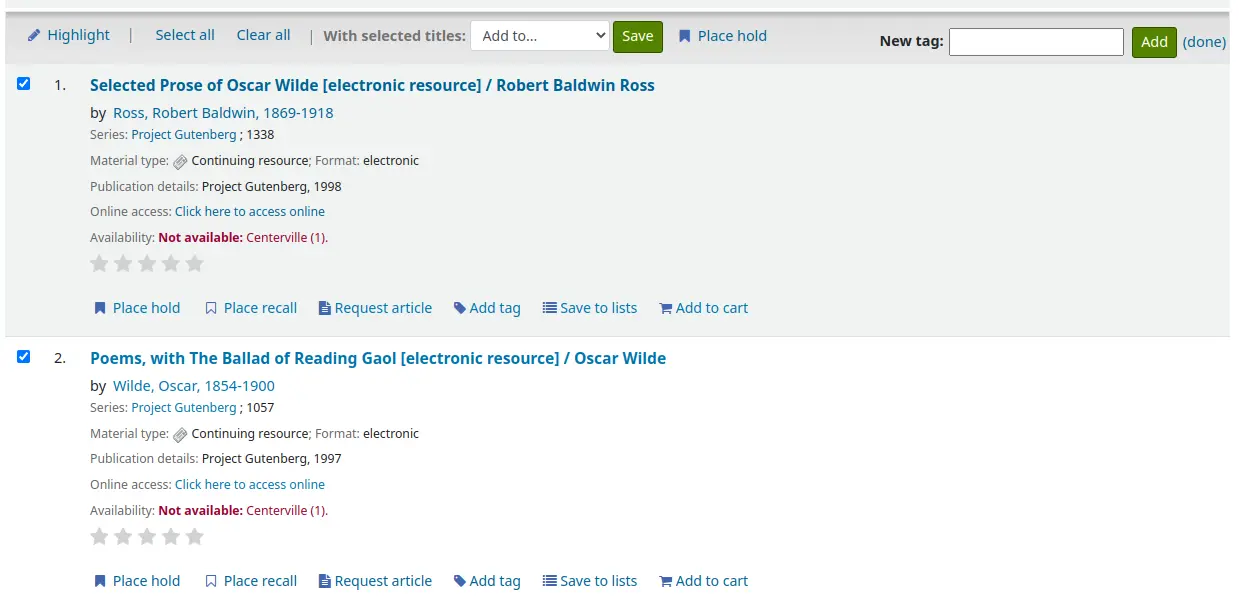
If the TagsInputOnDetail system preference is enabled, patrons will also have the possibility to add tags from a list and from the cart.
If the TagsInputOnDetail system preference is enabled, patrons will have the possibility of adding tags from the record detail page by clicking the “Add tag(s)” link. The link will be replaced by an input box.
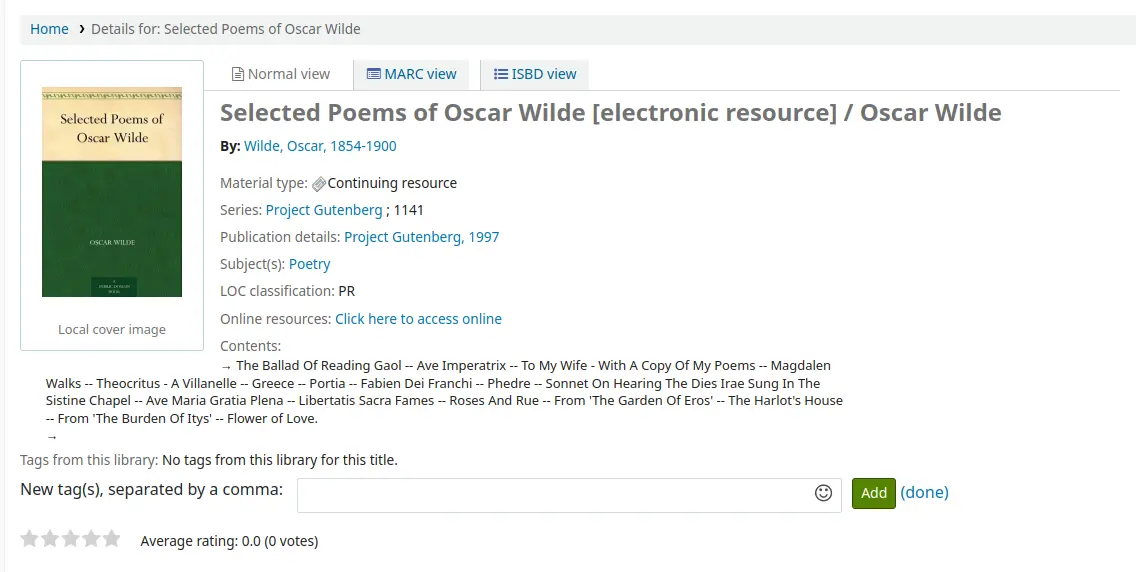
Emojis can also be included using the emoji picker when adding tags from the record detail page.
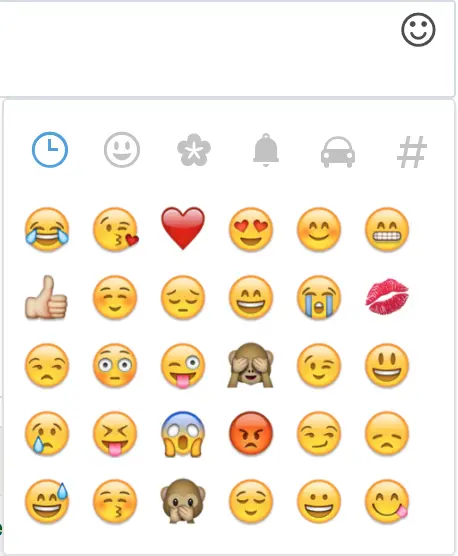
Zotero
Zotero è un add on di Firefox che consente di salvare e generare una bibliografia. Ulteriori informazioni e per scaricare Zotero vedere http://zotero.org.
Quando su risultati della ricerca in OPAC Koha, se avete installato Zotero, vedrete un’icona di cartella nella barra degli indirizzi a destra dell’URL. Facendo clic su tale cartella si aprirà un elenco di titoli nella pagina da scegliere per aggiungerli a Zotero.

Selezionare i titoli che si desidera aggiungere a Zotero e fare clic sul pulsante “OK”. Questo aggiungerà i titoli a Zotero. È possibile visualizzare il titolo aprendo poi la biblioteca di Zotero.

Feed RSS personalizzati
Using the RSS feeds cron job you can generate an RSS feed for any SQL query (for example a new acquisitions RSS feed). The cron job is run on the command line to produce an RSS XML document.
L’output va sistemato in una directory accessibile all’interfaccia dell’OPAC (o dello staff) affinché gli utenti possano scaricare il feed RSS.
Un esempio di utilizzo può essere trovato presso: misc/cronjobs/rss.pl lastAcquired.conf
Normalmente il cronjob RSS deve essere eseguito periodicamente (ad es., al giorno) per mantenere il feed aggiornati.
Elenca i file di configurazione (ad esempio, lastAcquired.conf)
nome del file da utilizzare come modello
percorso del file di output
Interrogazione SQL
Il cronjob RSS esegue la query SQL, quindi alimenta l’output della query attraverso il modello per produrre il file di output.
Importante
Per utilizzare i feed RSS personalizzati è necessario eseguire il RSS cron job.
OPAC self-registration
If you allow it, patrons can register for their own accounts via the OPAC. If you have the PatronSelfRegistration preference set to “Allow” then patrons will see a link to register below the log in box.
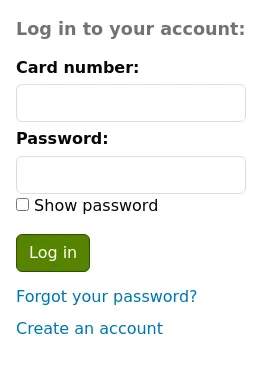
When the patron clicks the “Create an account” link they will be brought to a registration page. The options on the registration page can be controlled by editing the PatronSelfRegistrationBorrowerMandatoryField and the PatronSelfRegistrationBorrowerUnwantedField preferences.
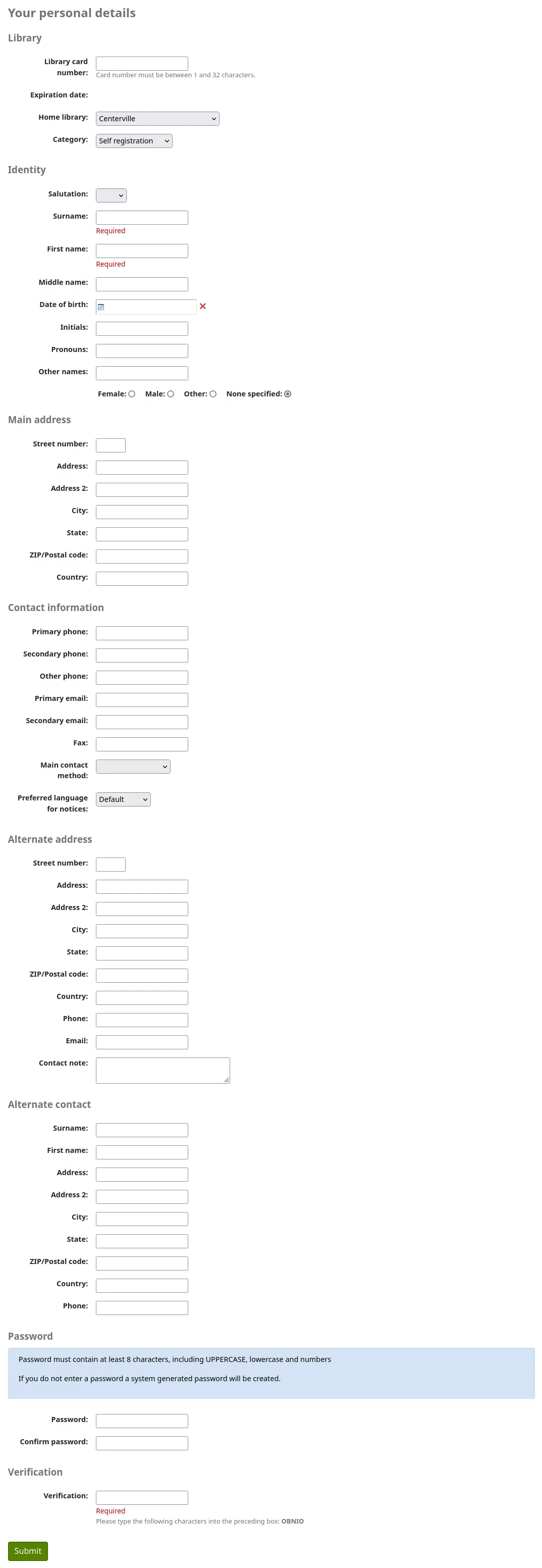
Nota
To prevent errors in birth years, you can enable the PatronSelfRegistrationAgeRestriction system preference. This adds a maximum age check to the self-registration.
Once the patron has submitted their registration they will either be sent an email to confirm their account (if you have the PatronSelfRegistrationVerifyByEmail preference to require this) or presented with their new username and password. If the PatronSelfRegistrationPrefillForm system preference is set to “Show and prefill”, they will be presented with the prefilled login form.

You can add additional instructions on this page by creating an HTML customization with the display location “PatronSelfRegistrationAdditionalInstructions”.
To be notified when a patron registers via the OPAC, use the EmailPatronRegistrations system preference, or the PatronSelfRegistrationAlert system preference.
Patrons registered in this way will not have a card number until assigned one by the library, but will have access to all OPAC functionality immediately. For this reason it is recommended that you:
set up a provisional patron category for self registered patrons (such as “Self-Registered) instead of using an existing patron category and set that value in the PatronSelfRegistrationDefaultCategory preference
give this patron category minimal circulation privileges in the circulation and fines rules (such as allowing a couple holds, but no check outs)
That way patrons will either have to come in to the library to verify their identity before given a card number and the ability to check items out or the library will have to come up with internal policy on generating card numbers before providing them to self-registered patrons. Once this is done the library can change the category to one that is more appropriate (be it an adult, resident, non resident, student, etc) and add a card number/barcode.
Il mio account
If the opacuserlogin system preference is set to “Allow”, patrons can log in and access their account.
Once logged in patrons are brought to their account summary.
If patrons access the home page while logged in, and OPACUserSummary is set to “Show”, they will see a small summary of their account instead of the login fields.

If OPACShowSavings is set to display savings in the summary box, this summary section will also contain the savings the patron made by using the library rather than purchasing the items.
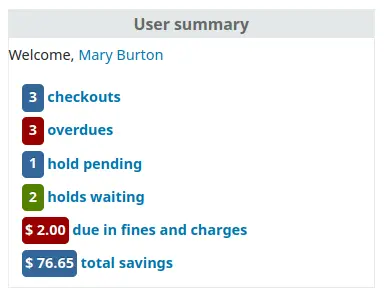
From any page on the OPAC, clicking on their name at the top right of the page will bring a patron back to their account.
Reimpostazione della password
If you have the OpacResetPassword system preference set to “Allow”, patrons can reset their password by clicking the “Forgot your password?” link found under the login box.

Once clicked, they will be presented with a form asking for their login or their email address.
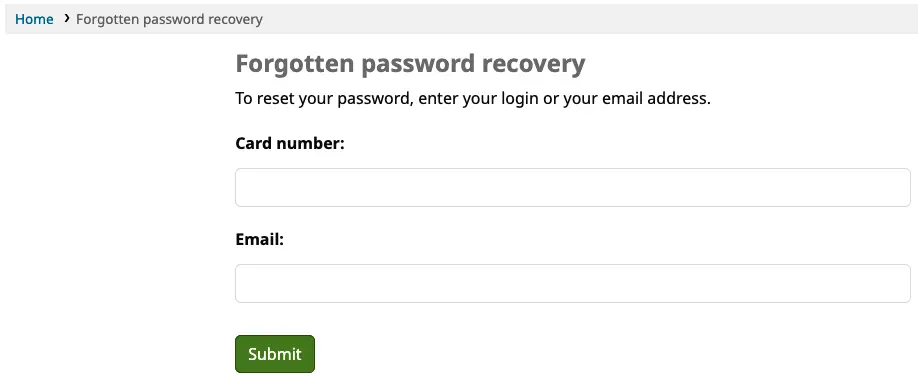
Avvertimento
Patrons must have an email address on file to reset their password. If they don’t have an email address already in their file, they will get an error message

Il sistema invierà all’utente le istruzioni per reimpostare la password.

The content of the email can be customized with the Notices and slips tool. The code of the letter is PASSWORD_RESET.
If the NotifyPasswordChange system preference is enabled, the patron will receive a notification indicating their password was changed.
The content of that email can be customized with the Notices and slips tool. The code of the letter is PASSWORD_CHANGE.
I miei dati in breve
From the “your summary” tab, patrons will see all of the items they have checked out with the overdue items highlighted in red.
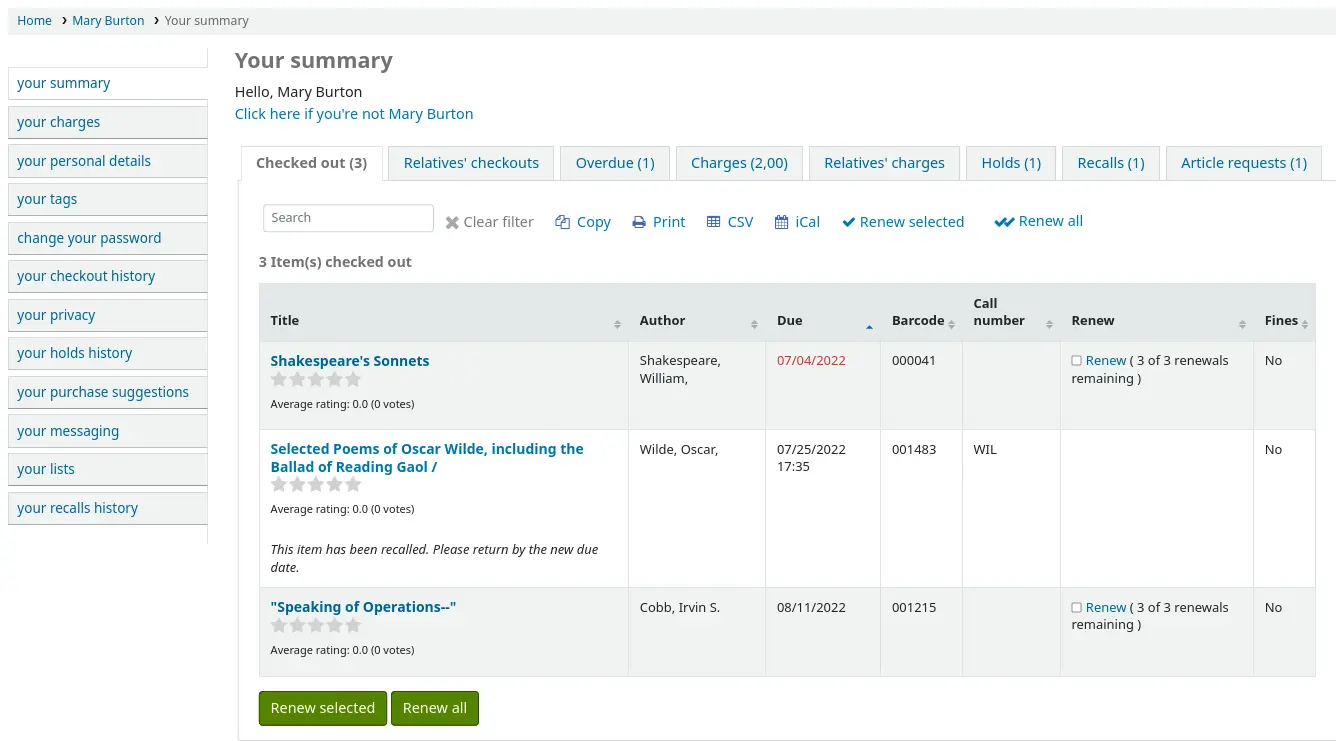
OPAC messages and OPAC notes will be displayed at the top of this page. For OPAC messages, the patron will have the option to dismiss the message. This will hide the message from their OPAC account and mark it as read, but it will not delete the message.

You can add content to this page with the OpacMySummaryNote HTML customization location. Content added there will appear above the patron’s summary and below the welcome message.

If OPACShowSavings is set to display savings in the “your summary” page, this section will also contain the savings the patron made by using the library rather than purchasing the items.

If OpacRenewalAllowed set to “Allow”, patrons will be able to renew their checkouts from the OPAC.
If the patron has pending charges exceeding the value set in OPACFineNoRenewals, a note will display explaining that renewals cannot be made.

A note will display if the patron cannot place holds due to their charges exceeding the value set in the maxoutstanding system preference.

If AllowPatronToControlAutoRenewal is set to “Allow patrons”, patrons will be able to choose whether or not they want their checkouts to be renewed automatically. If they choose ‘Yes’, items for which automatic renewal is enabled in the circulation rules will renew as expected. If they choose ‘No’, the automatic renewals that would have applied to this patron’s checkouts will not take place.

If you have HTML entered in the OPACMySummaryHTML preference then you will see that to the right of the “Fines” column.
Suggerimento
By default, the barcode is not displayed in the patron’s checkout table on the OPAC. If your patrons would like to see the items barcodes on their list of checked out items you can set up a patron attribute with the value of SHOW_BCODE and authorized value of YES_NO.
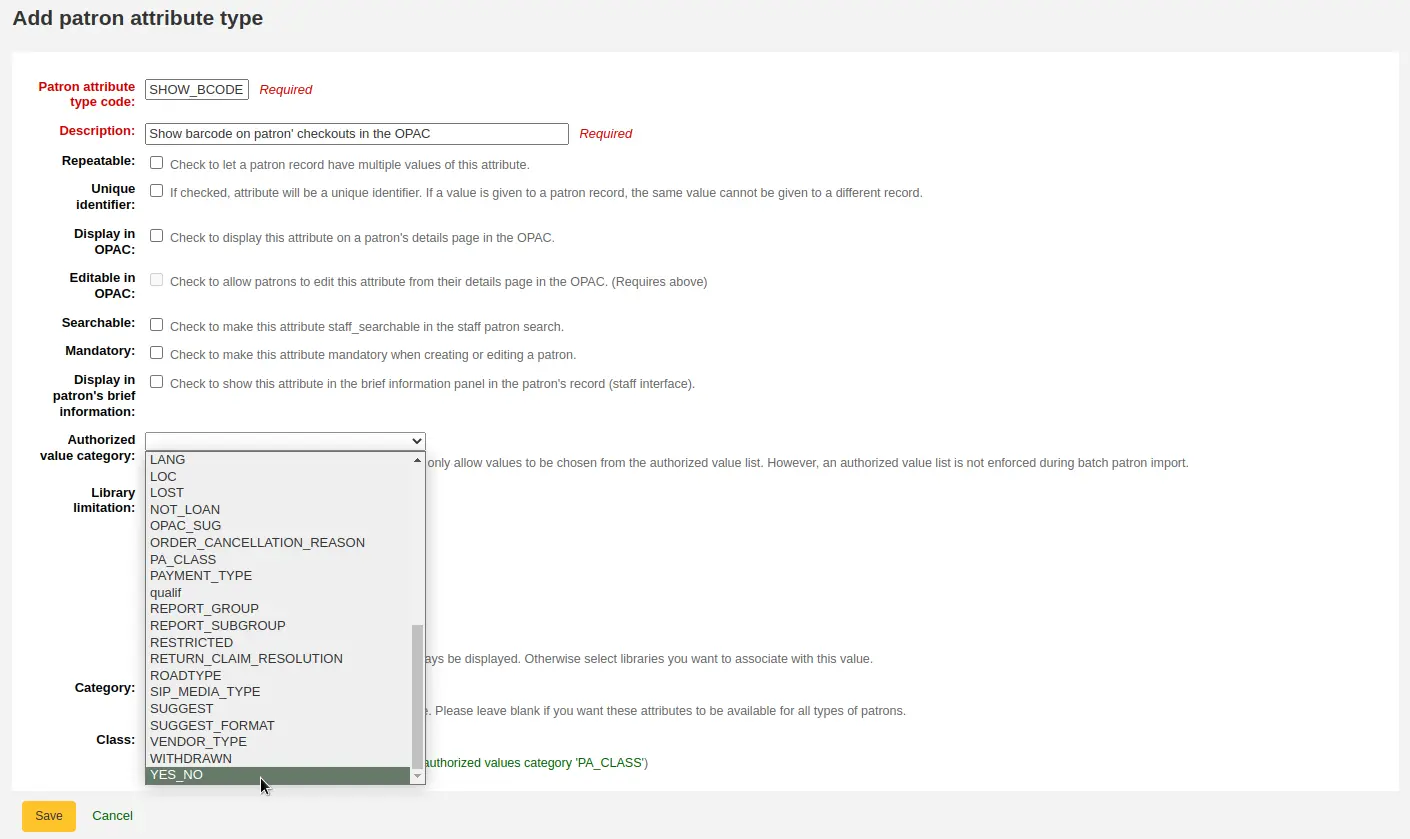
Then, on the patron’s record set the value for SHOW_BCODE to “Yes”.

This will add a column to the checkout summary in the OPAC that shows the patron the barcodes of the items they have checked out.
If you would like your patrons to leave a note on an item they have checked out AllowCheckoutNotes preference must be set to allow.
In the patron’s summary of checkouts, there will be an added column to allow the patron to leave a note (for example: missing first page, or DVD is scratched).
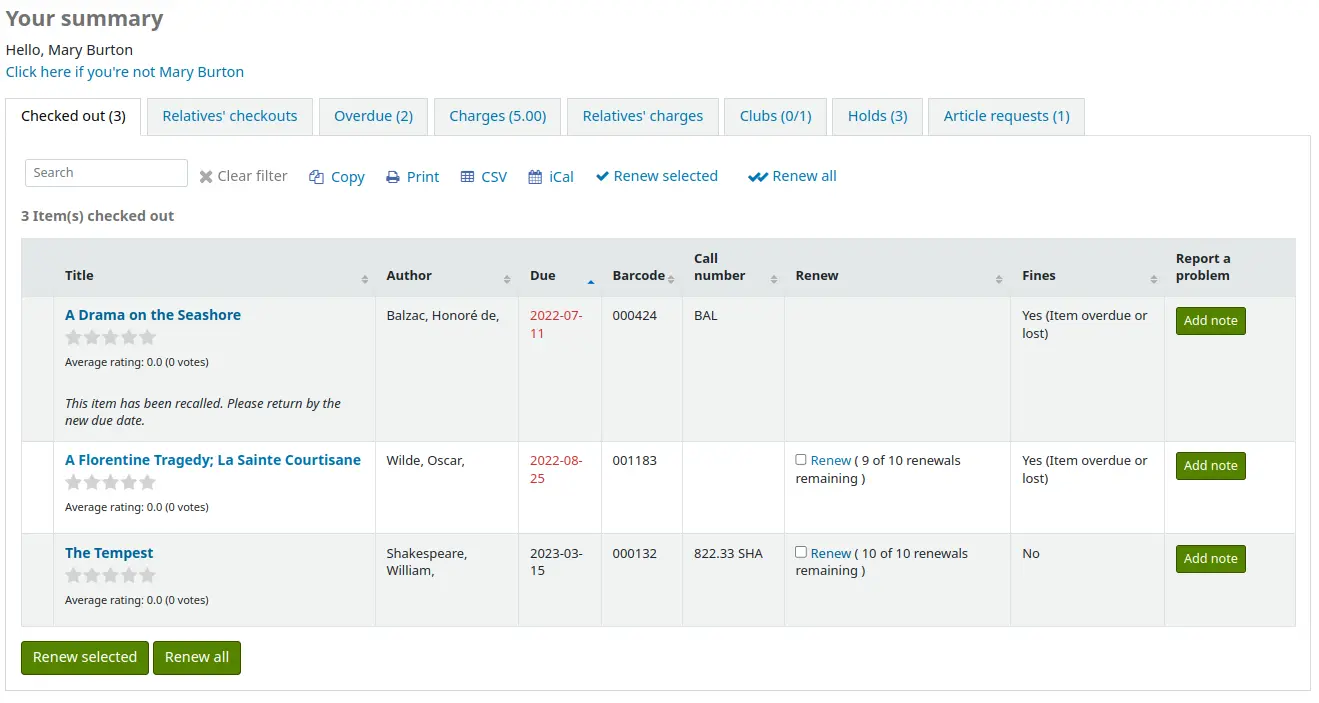
When the patron clicks on “Add note”, they will be able to write a note about this checkout.

Staff will be able to see and manage checkout notes from the staff interface.
If their guarantee has allowed it via their privacy, or alternatively, if the staff is allowed to change this privacy setting in the staff interface with the AllowStaffToSetCheckoutsVisibilityForGuarantor system preference and this setting is turned on, when the guarantor logs in they will see a tab labeled «Relatives” checkouts» on their summary tab.

Facendo clic sulla scheda “in ritardo” verranno mostrate solo le copie prestate in ritardo di restituzione.
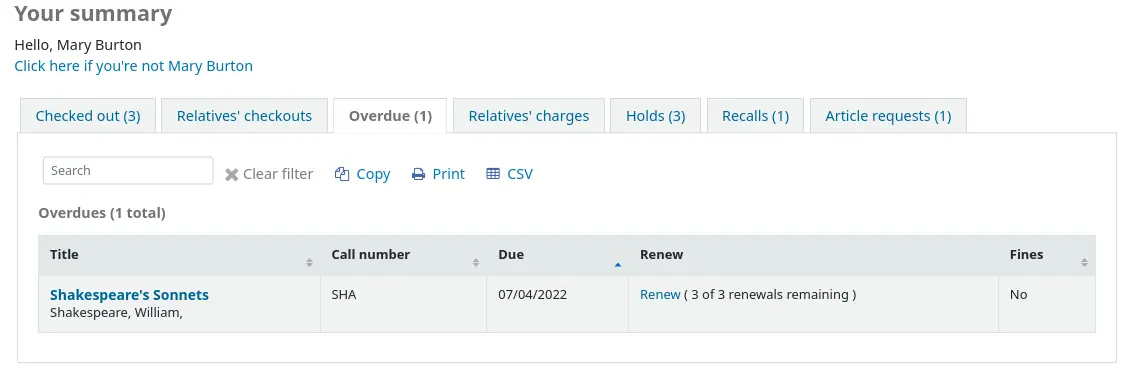
The “Fines” tab will show just a total of what the patron owes. Clicking on the total will take them to the “your fines” tab where they will see a complete breakdown of their fines and bills. If you don’t charge fines at your library you can turn the display of these tabs off by setting the OPACFinesTab preference to “Don’t allow.”

If their guarantee has allowed it via their privacy, or alternatively, if the staff is allowed to change this privacy setting in the staff interface with the AllowStaffToSetFinesVisibilityForGuarantor system preference and this setting is turned on, when the guarantor logs in they will see a tab labeled «Relatives” charges» on their summary tab.

The “Clubs” tab shows all ongoing clubs which allow public enrollment. From here, patrons can enroll in clubs by clicking the “Enroll” button.

The “Holds” tab shows the patron the status of all of the items they have on hold.
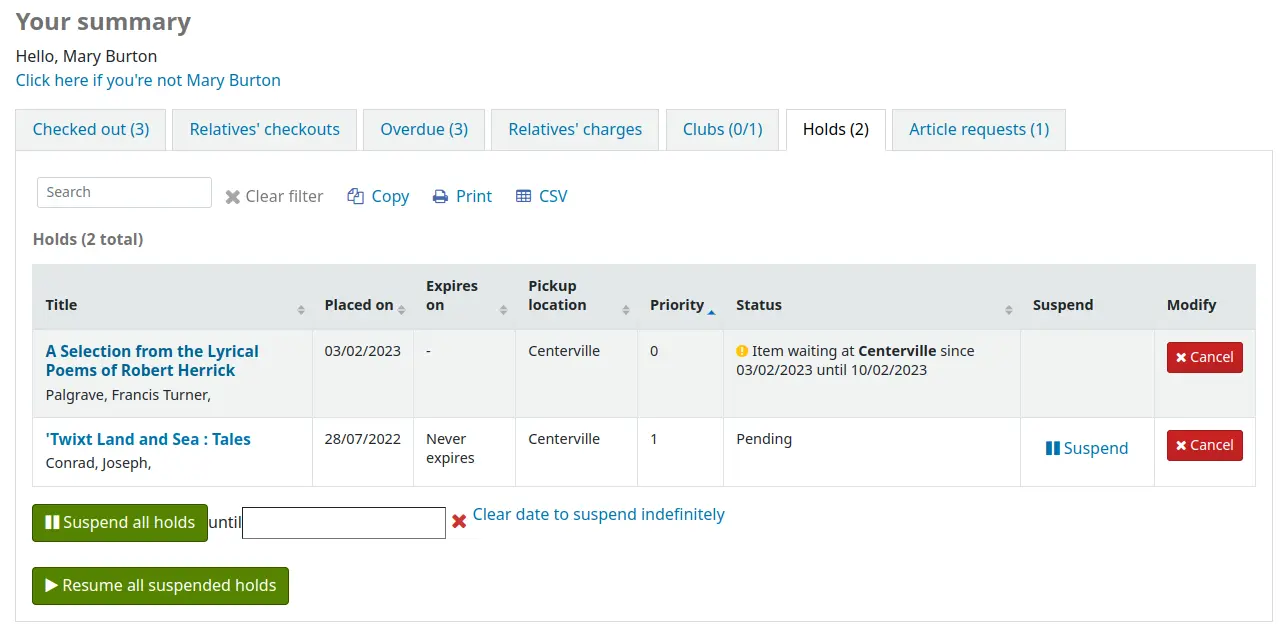
Depending on the value of the SuspendHoldsOpac system preference, patrons can suspend their own holds if they are not in transit or already waiting for them. When they click “Suspend” they will be presented with the option to choose a date for their hold to resume.
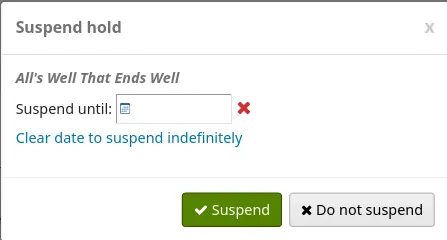
Essi possono anche sospendere tutte le prenotazioni indefinitamente o fino a una data specifica che scelgono compilando le opzioni per la sospensione in fondo alla pagina.
Nota
If the AutoResumeSuspendedHolds system preference is set to «Don’t allow», patrons will not have the option to put an end date on the hold suspension.
From this tab, patrons can also cancel holds. Depending on the waiting hold cancellation policy, they may also be able to cancel holds that are already waiting for them.
Depending on the value of the OPACAllowUserToChangeBranch system preference, the patron may be able to change the pickup library of holds. When one or more status is selected in the system preference, a “Change” link will appear under the current pickup library’s name for holds that have that status.
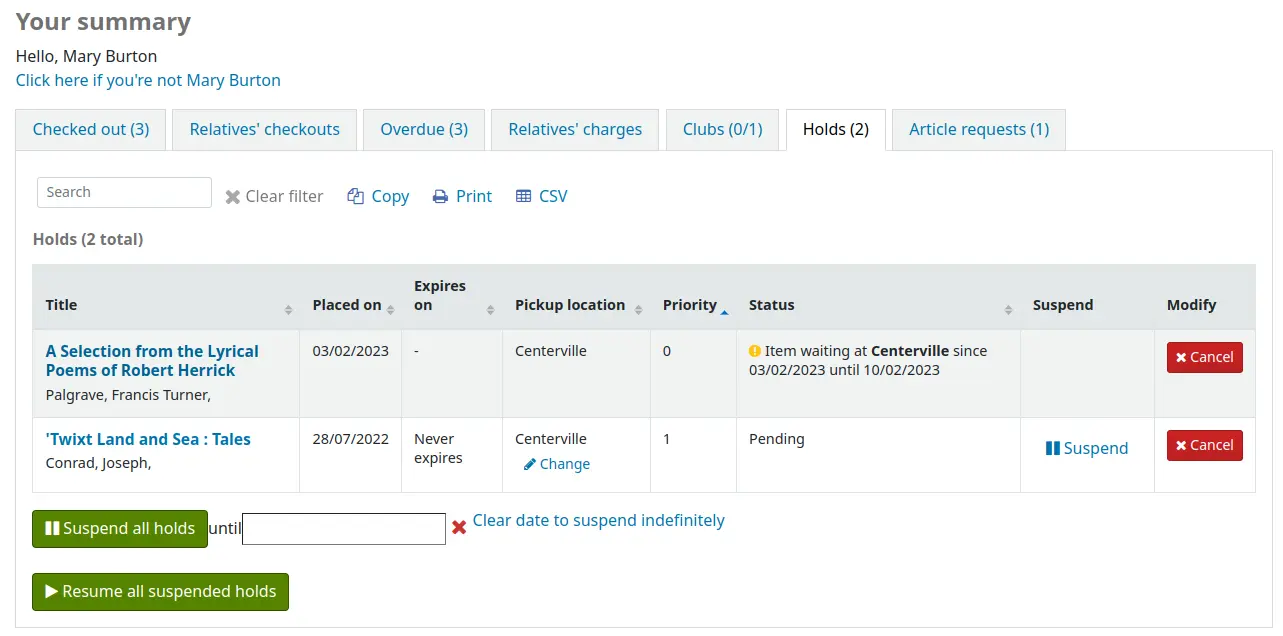
When the patron clicks on the “Change” link, there is a pop-up with a selection of libraries that allow hold pickups.
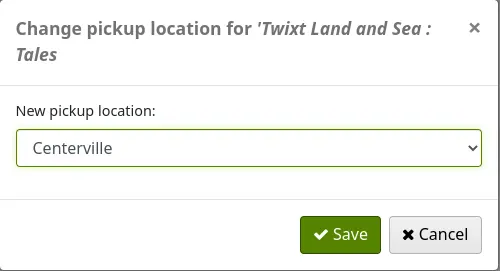
If your library allows recalls, the patron can see the recalls they have requested and their various statuses in the “Recalls” tab.
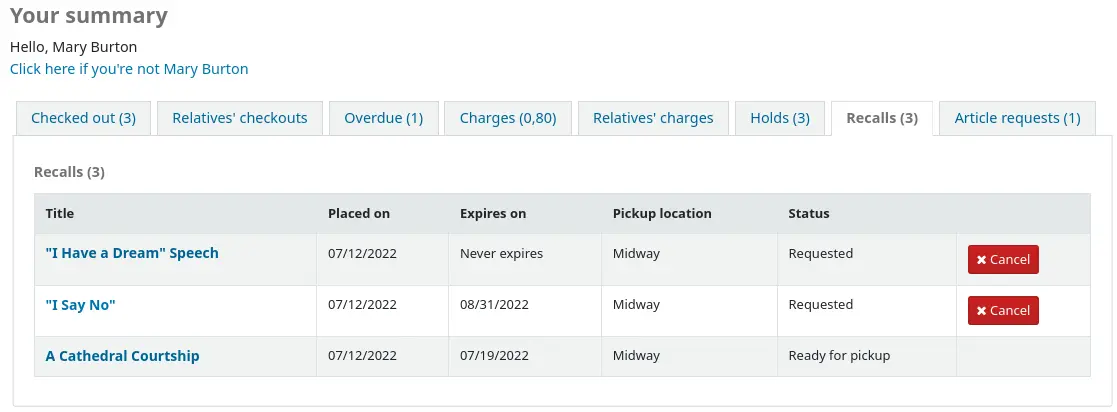
The patron can cancel a recall by clicking the “Cancel” button, provided that it is not already awaiting pickup.
Permessi utente
If you have flagged your patron’s account they may see one of the following error messages at the top of their account.
Tessera contrassegnata come smarrita

Indirizzo da modificare

Nota
this error message will not include a link to the update form if you have OPACPatronDetails set to “Don’t allow”
Utente contrassegnato come limitato

Le tue multe
Se la biblioteca prevede multe, la scheda successiva a sinistra è “le mie multe.” L’apertura di questa scheda mostra all’utente tutta la storia della sua contabilità con la biblioteca.
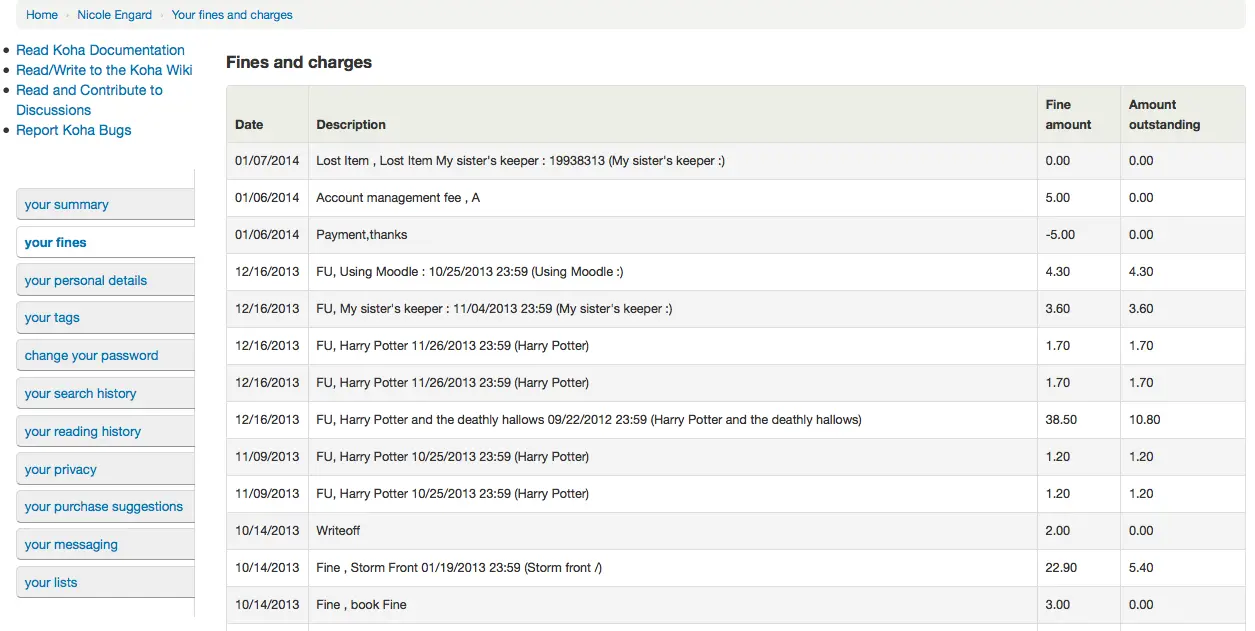
If you are allowing patrons to pay their fines using PayPal with the EnablePayPalOpacPayments preference there will be checkboxes to the left of each fine with an outstanding amount.

Nella parte inferiore l’utente vedrà la possibilità di pagare con PayPal per quanto ha selezionato.
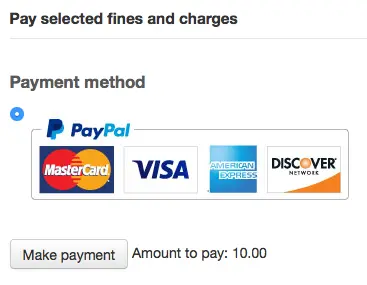
Dopo aver pagato, ti verrà presentato un messaggio di conferma

E vedrai che la multa è stata pagata tramite PayPal dentro l’interfaccia del bibliotecario.
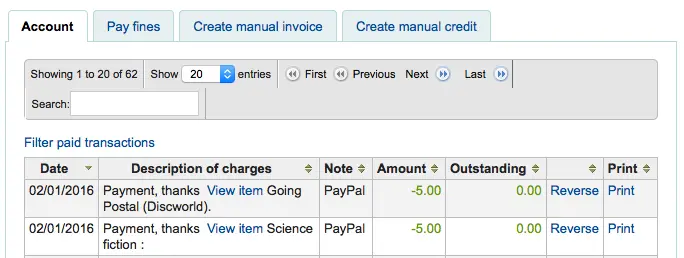
il tuo profilo
If you have your OPACPatronDetails preference set to “Allow”, your patrons will see a form filled in with their contacting information by clicking on the “Your personal details” tab. You can control what fields patrons see and can modify via the OPAC by setting the PatronSelfModificationBorrowerUnwantedField and PatronSelfModificationMandatoryField preferences.
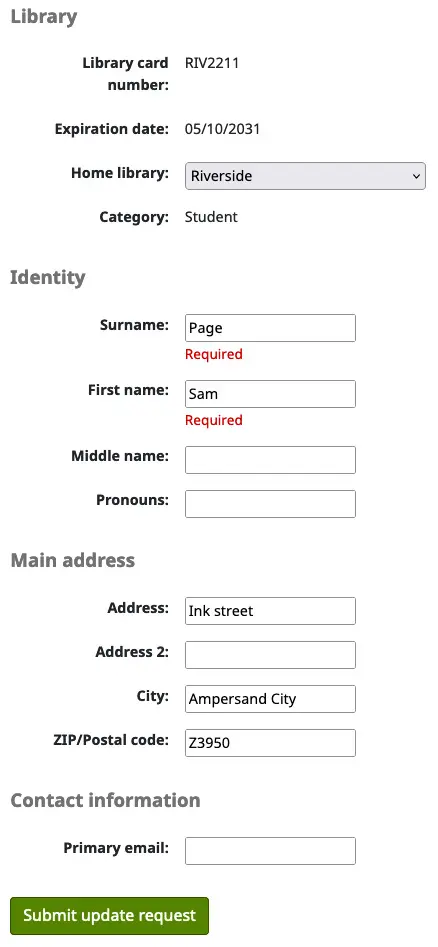
Gli utenti possono modificare i propri dati in questo modulo e cliccare su “Invia modifiche” per inviare le modifiche alla biblioteca per la revisione prima che il loro record venga aggiornato. Il personale vedrà le richieste di modifica degli utenti in una lista sotto i moduli della homepage dell’interfaccia dello staff, insieme a qualsiasi altra cosa in attesa di attenzione da parte della biblioteca.

If the AutoApprovePatronProfileSettings system preference is enabled, staff will not need to approve changes.
If the OPACPatronDetails preference is set to “Don’t allow” then patrons will simply see their details and a message stating that they should contact the library for changes.
Consents
If you have set the system preference PrivacyPolicyConsent to “permissive” or “enforced” then logged in patrons in the OPAC will have a tab labeled “Consents” where their consent statements are saved. By default the library’s privacy policy is referred to in the consent statement. You can use a URL to link to your own privacy policy using the system preference PrivacyPolicyURL.

Version
A new plugin hook for “patron_consent_type” was added in version 23.11 of Koha to allow for further types of consent in the OPAC. See the Plugin Hooks page on the wiki for more information.
Cambiare password
Next, if you have OpacPasswordChange set to “Allow” the next tab will be “change your password,” where patrons can change their password for logging into the OPAC. Patrons will be presented with a standard form asking them to enter their old password and then their new password twice.
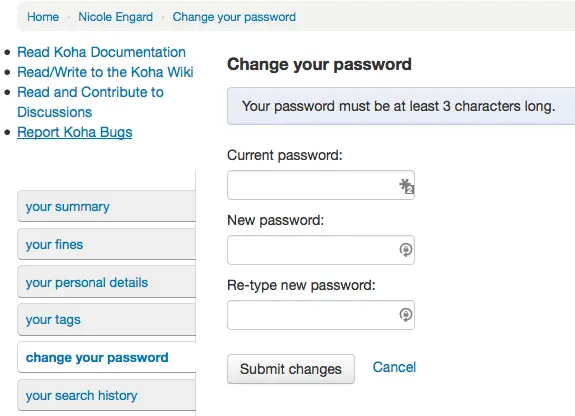
If the NotifyPasswordChange system preference is enabled, the patron will receive a notification indicating their password was changed.
The content of this email can be customized with the Notices and slips tool. The code of the letter is PASSWORD_CHANGE.
Cronologia ricerche
If you have your EnableOpacSearchHistory preference set to “Keep” then your patrons can access their search history via the “your search history” tab.
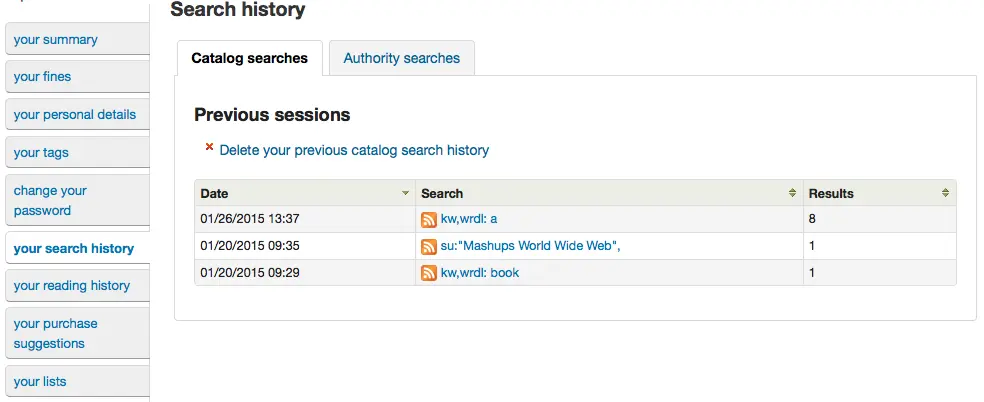
La cronologia delle ricerche è una registrazione di tutte le ricerche gestiti dal patron. Cliccando su una qualsiasi delle frasi di ricerca si riesegue la ricerca. La cronologia di ricerca può essere eliminato dall’utente in qualsiasi momento cliccando sul pulsante “Elimina la cronologia di ricerca” posto nella parte superiore di questa scheda o facendo clic sul piccolo rosso “x” accanto al link “Ricerche effettuate” in alto a destra dell’OPAC.

Checkout history
If the opacreadinghistory system preference is set to “Allow”, patrons will have access to the “Checkout history” tab. This will show the patron their entire borrowing history, unless they have asked the library to not keep that information via the “Privacy” tab.
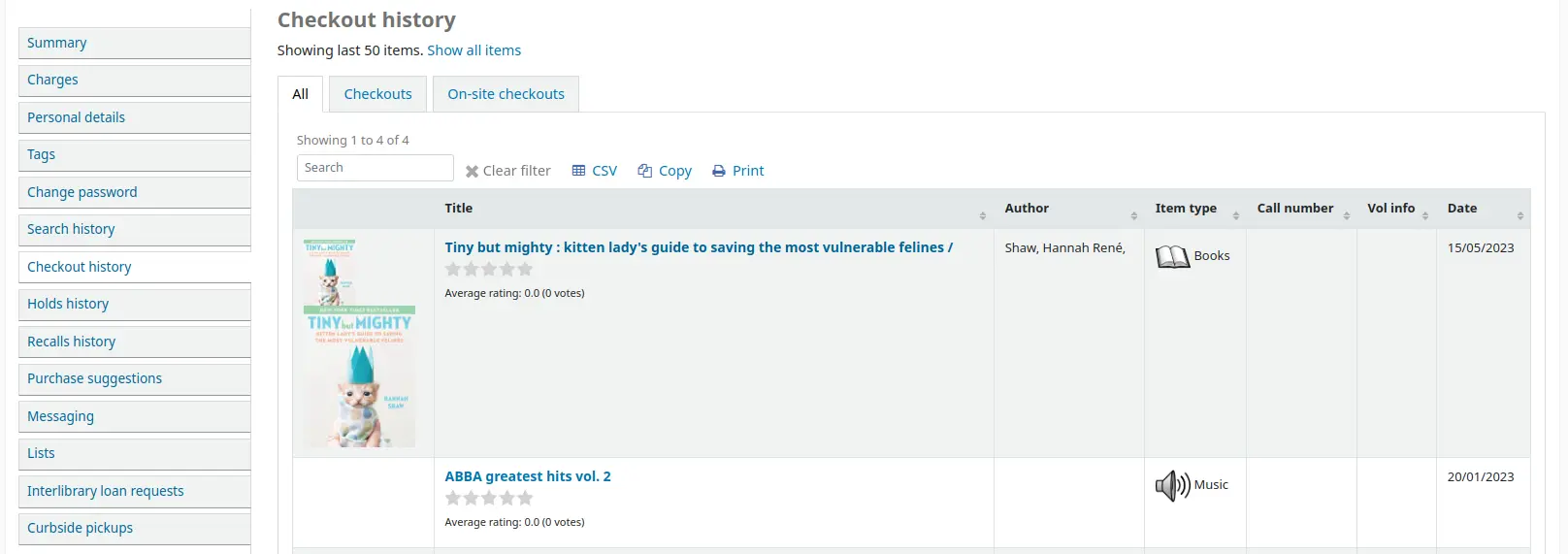
If OPACShowSavings is set to display savings in the “your summary” page, this section will also contain the savings the patron made by using the library rather than purchasing the items.

La mia Privacy
The “your privacy” tab will appear if you have both the opacreadinghistory and the OPACPrivacy preferences set to “Allow.” This tab will allow the patrons to decide how the library keeps their circulation history data.

L’utente può scegliere tra tre opzioni:
Sempre: mantieni traccia dei mie prestiti per sempre. Questa opzione è per quegli utenti che voglio ricordarsi di tutto quello che hanno letto.
Predefinito: conserva il mio storico prestiti secondo le leggi locali. Questa è l’opzione predefinita: la biblioteca conserverà il tuo storico prestiti per la durata ammessa dalle leggi locali.
Mai: cancella subito i miei prestiti. La registrazione del prestito verrà cancellata al momento della restituzione.
Depending on the patron’s suggestions the contents of the “Your reading history” tab and the “Circulation History” tab in the staff client may change.
Indipendentemente dalla sua scelta, l’utente può cancellare la sua storia di lettura in blocco in qualsiasi momento facendo clic sul pulsante “eliminazione immediata”.

Facendo clic su questo pulsante non eliminerà le copie attualmente in prestito, ma cancellerà la precedente cronologia di lettura dell’utente.
Importante
In order for the patron to be able to delete their reading history you must have the AnonymousPatron preference set.
If you’re allowing guarantees to grant permission to their guarantors to view their current checkouts with the AllowPatronToSetCheckoutsVisibilityForGuarantor preference they will see that option on this screen.
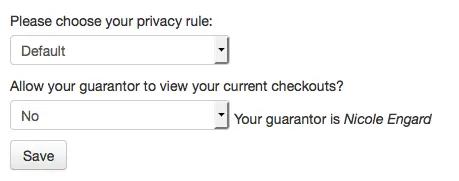
Quando il garante si collegherà egli avrà a disposizione una scheda con «Prestiti dei parenti» dentro la sua scheda di riepilogo.

Your holds history
If the OPACHoldsHistory system preference is set to “Allow”, patrons will be able to see all their current and past holds.

I miei suggerimenti di acquisto
If your library allows patrons to make purchase suggestions the next tab will show all suggestions that the patron made to the library and their statuses. To disable this tab and the suggestion functionality set the suggestion preference to “Don’t allow.”
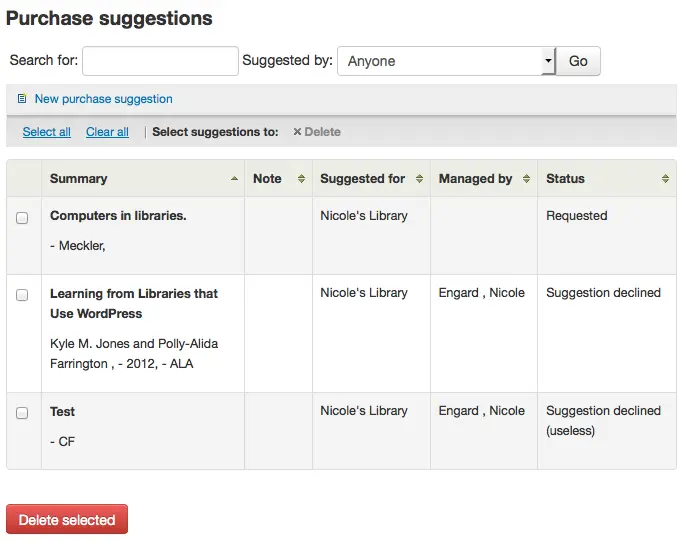
If you have OPACViewOthersSuggestions set to “Show” then patrons will be able to search suggestions from the top of this list.
Messaging
If your library has the EnhancedMessagingPreferences and the EnhancedMessagingPreferencesOPAC preferences set to “Allow” then your patrons will be able to choose which messages they receive from the library (with the exception of overdue notices which the library controls).
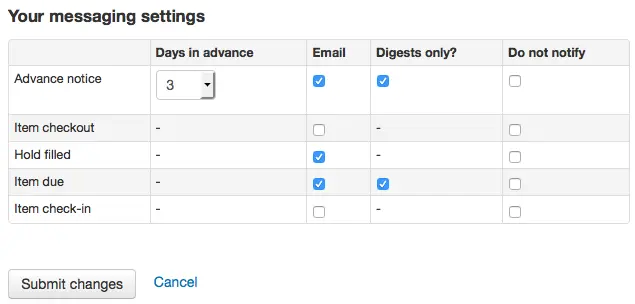
If you use an outside driver for sending text messages set with the SMSSendDriver preference, you will see an additional column to receive these messages as SMS (or text messages) and a field for a cell (or SMS) number.

If you are using the Email protocol for sending text messages set with the SMSSendDriver preference, you will see an additional column to receive these messages as SMS (or text messages), a field for a cell (or SMS) number, and a pull down listing cellular providers entered in administration.
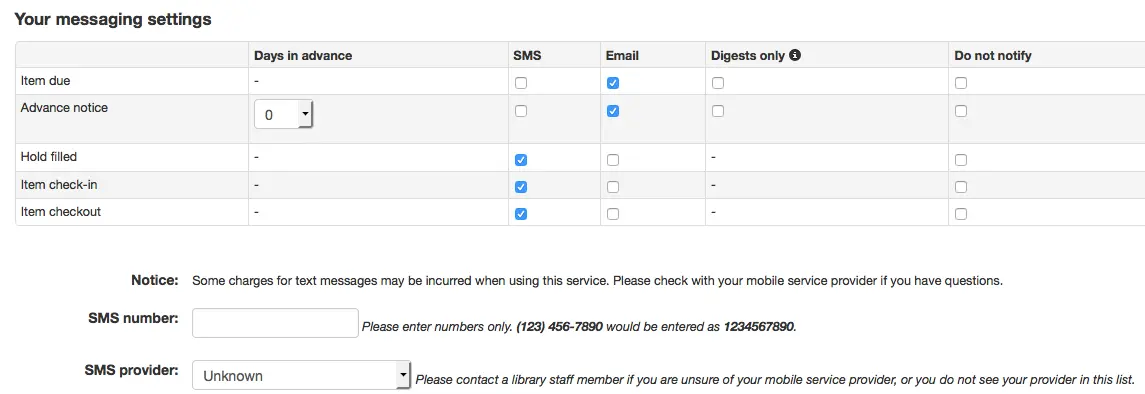
If you are using the i-tiva Talking Tech service you will see an additional column to receive these messages via Phone.
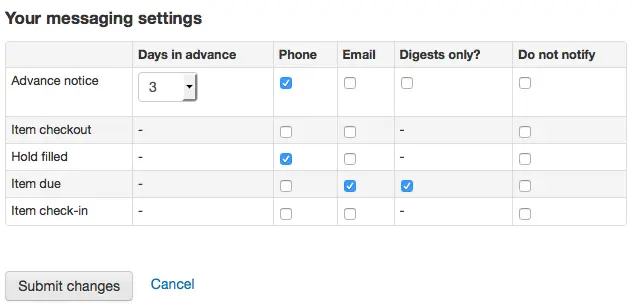
Questi avvisi sono:
Preavviso: Un preavviso all’utente con le copie che stanno per scadere (l’utente può scegliere il numero di giorni di anticipo)
Prestito di una copia: un avviso che elenca tutte le copie che l’utente ha preso in prestito e/o rinnovato; è la versione elettronica della ricevuta dei prestiti
Prenotazione accettata: Un avviso quando hai confermato che la prenotazione è in attesa di ritiro da parte dell’utente
Copia in scadenza: Un avviso nel giorno in cui una copia deve essere restituita alla biblioteca
Copia restituita: Un avviso che elenca le copie da poco restituite dall’utente
Nota
This notice can be customized by editing the CHECKIN notice in the Notices and slips tool.
Prestito di una copia: un avviso che elenca tutte le copie che l’utente ha preso in prestito e/o rinnovato; è la versione elettronica della ricevuta dei prestiti
Nota
This notice can be customized by editing the CHECKOUT notice in the Notices and slips tool.
Auto renewal: A notice that notifies the patron that their checkouts have been automatically renewed, or if there was a problem with their automatic renewal.
Nota
This notice can be customized by editing the AUTO_RENEWAL or AUTO_RENEWAL_DGST notices in the Notices and slips tool.
This option will only appear if the AutoRenewalNotices is set to «according to patrons messaging preferences».
Gli utenti possono scegliere se ricevere gli avvisi come digest spuntando la casella “solo digest” e il metodo di spedizione. Il digest è un raggruppamento di tutti i messaggi di un certo tipo (p.es. tutte le copie da restituire nei prossimi 3 giorni in un solo messaggio) invece di un messaggio per avviso.
If the TranslateNotices preference is set to Allow the patron will also see an option to choose “Preferred language for notices” with a dropdown list of available languages.
Importante
È necessario scegliere un metodo di consegna (SMS o e-mail o telefono), insieme a “solo digest?” se si desidera ricevere i messaggi raggruppati.
Liste
If the virtualshelves system preference is set to “Allow”, patrons will see a “Lists” tab.
From here, patrons can view public lists and create or edit their own private lists.

My virtual card
Version
This feature was first introduced in version 24.11 of Koha.
If the OPACVirtualCard system preference is set to “Allow”, patrons will see a “My virtual card” tab where their library card barcode is displayed.

If the patron has logged in to their OPAC account from a mobile device, their barcode can then easily be scanned by library self-service kiosks and other services.
Alert subscriptions
Version
This section was added to Koha in version 23.11.
If the RoutingSerials system preference is enabled, patrons who have opted in to email alerts for new serial issues via the “Subscriptions” tab in the bibliographic record will see an “Alert subscriptions” tab in their account.

This tab lists all the serial email alerts the patron has subscribed to. Patrons can cancel alerts by clicking the “Unsubscribe from email alerts” link if desired.
Chiedi una liberatoria
If the useDischarge system preference is enabled, patrons will be able to request a discharge via the OPAC. A discharge is a certificate that says the patron has no current checkouts and no holds.
Patrons can request a discharge from the library by going to the “Ask for discharge” tab in their online account.

From here they can request a discharge by clicking the “Ask for a discharge” button. They will receive a confirmation of their request.
Once the discharge is approved by library staff, the patron will see a download link to download a PDF of their discharge.

Le mie routing list
Se sei un destinatario elencato in serial routing lists, le vedrai elencate qui. La seguente nota verrà visualizzata «Sei abbonato alla routing list per i seguenti titoli di periodici. Se vuoi cambiamenti, per favore contatta la biblioteca».
Le tue richieste di prestito interbibliotecario
If your library has the ILLModule preference set to ‘Enable’ patrons will have the option to make ILL requests when logged in to their OPAC account. From here they can view their existing requests and place new ones.

Per procedere a una nuova richiesta di prestito, clicca su «Crea una nuova richiesta» e scegli una form.
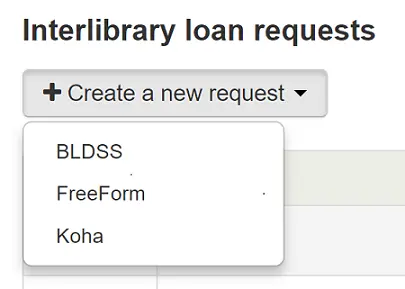
Nota
The options displayed are dependent on your ILL configuration. See the ILL backends wiki page at https://wiki.koha-community.org/wiki/ILL_backends further explanation.
Nota
If there is a copyright clearance text in a “ILLModuleCopyrightClearance” HTML customization display location, the text displays here and patrons need to click “Yes” to accept before continuing.
Complete the publication details as fully as possible. Depending on the form in use you may see the option to add Custom fields for additional information such as notes. Destination branch is a required field, this is the branch you would like the request to be sent to.
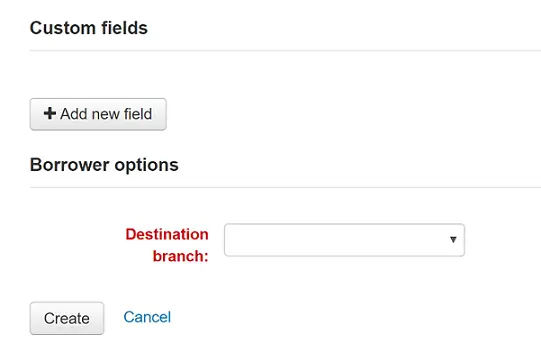
Clicca su “Crea” per inviare la tua richiesta alla biblioteca.
Your submitted request will be listed with a status of ‘New request’. Once processed the status will be updated to ‘Requested’.
Clicca su “Vedi” per modificare o cancellare la richiesta.
You cannot edit the form details but you can add a note to request a modification and then click on ‘Submit modifications’ at the bottom of the screen. Your modification will be sent to the library for processing.
Nota
When a patron modifies an inter-library loan request, an email is sent to library staff so that they can view the changes from the ILL module.
The email sent is based on the ILL_REQUEST_MODIFIED template. It can be customized in the Notices and slips tool.
Per le nuove richieste hai anche la possibilità di “Chiedere la cancellazione”. La tua richiesta passerà allo stato “Cancellazione richiesta” e verrà poi rimossa dallo staff della biblioteca.
Nota
When a patron cancels an inter-library loan request, an email is sent to library staff so that they can cancel it from the ILL module.
The email sent is based on the ILL_REQUEST_CANCEL template. It can be customized in the Notices and slips tool.
Your recalls history
If your library allows recalls, the patron can see all their past and current recalls they have requested and their various statuses in the “your recalls history” tab.

The patron can cancel a recall by clicking the “Cancel” button, provided that it is not already awaiting pickup.
Curbside pickups
If your library offers curbside pickup, the patron will be able to see their scheduled pickups under “Curbside pickups”.

The patron has the option to indicate that they are outside the library by clicking “Alert staff of your arrival”.
The patron also has the option to cancel their scheduled pickup with the “Cancel this pickup” button.
If the “Patron-scheduled pickup” setting is turned on in the curbside pickup configuration, the patron will be able to schedule their own curbside pickup appointment.

The patron must first choose a library at which they want to pick up their items
Nota
Only libraries with curbside pickup enabled will be displayed in the drop-down menu.
Furthermore, if the “Enable for waiting holds only” setting is turned on, only the libraries at which the patron has waiting holds will be enabled.
The patron must then choose a date
Nota
Only dates with available time slots will be displayed.
The possible pickup times will be displayed, depending on the day of the week

Nota
The number in parentheses under each time slot is the number of available appointments for that time. If the maximum number of appointments has been reached, based on the “Maximum patrons per interval” setting in the curbside pickup configuration, the time slot will be grayed out and the patron will not be able to select it.
The patron can optionally add a note about their pickup
The patron must then click “Schedule pickup” to save their appointment
Suggerimenti di acquisto
If your library has the suggestion preference set to “Allow”, patrons will have the option to make purchase suggestions in several areas in the OPAC.
If you are allowing everyone to see the purchase suggestions made by others with the OPACViewOthersSuggestions preference, there will be a link at the top of your OPAC under the search box.

Ci sarà un collegamento quando l’utente non trova nulla con la ricerca.

There will be a “Suggest for purchase” option in the detailed view of a bibliographic record.

And there will be a link in the Your purchase suggestions tab in the patron’s account.
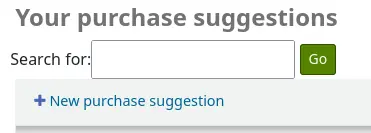
Facendo clic su uno qualsiasi di questi link si aprirà il modulo dei suggerimenti di acquisto.
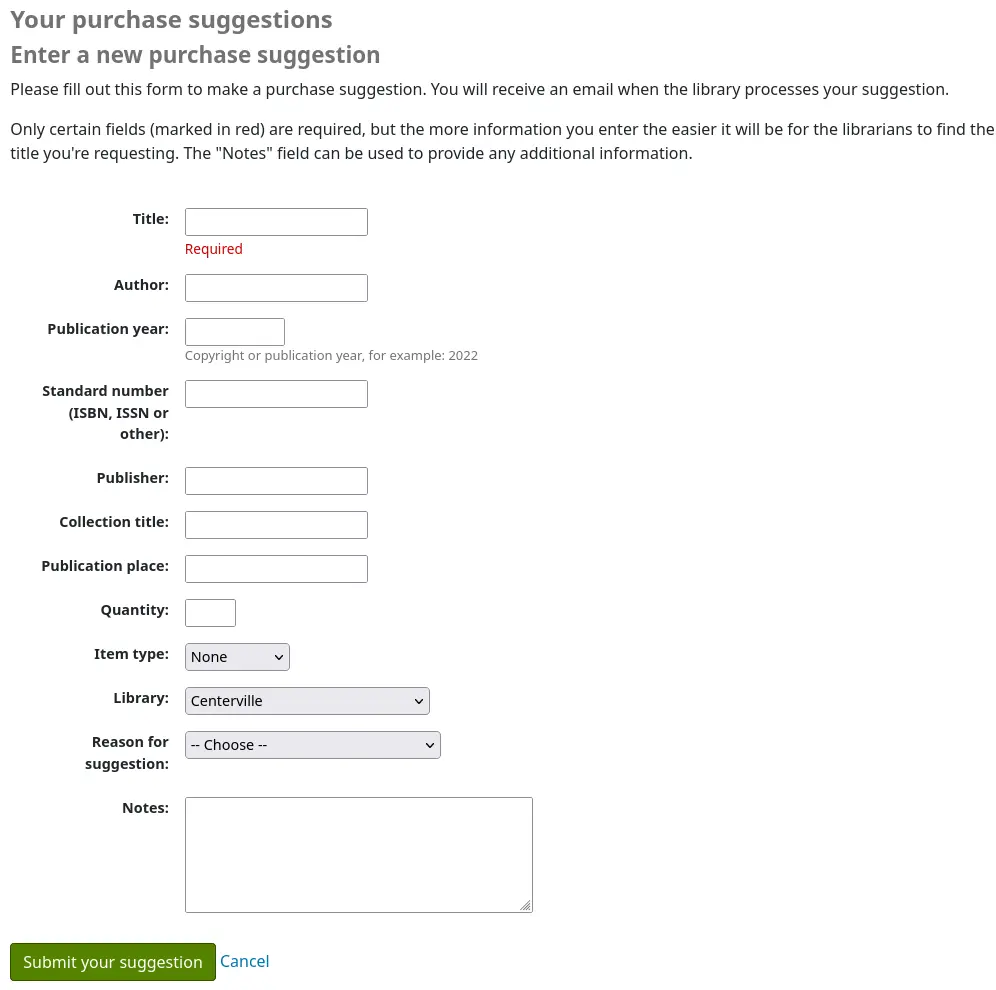
The informational text at the top of the form can be replaced using the HTML customizations tool, display location OpacSuggestionInstructions.
From the form only the “Title” is required by default.
Mandatory fields can be set using the OPACSuggestionMandatoryFields system preference.
The OPACSuggestionUnwantedFields system preference can be used to hide unnecessary fields.
The OPACSuggestionAutoFill system preference can be used to help patrons fill out the form using information from Google Books.
The item type list can be edited by editing the SUGGEST_FORMAT authorized value list.
The “Reason for suggestion” list can be edited by editing the OPAC_SUG authorized value list.
If the item already exists in the catalog, the patron will see a message with what Koha thinks is the corresponding title. Matches are made on the title/ author, ISBN or ISSN. If the title isn’t what the patron is trying to suggest, they can click “Confirm your suggestion”, to suggest it anyway.

Once the form is submitted the purchase suggestion will appear in the acquisitions module for the librarians to manage.
If a purchase suggestion has been ordered through the acquisitions module, the patron’s purchase suggestion title will be clickable and bring the patron directly to the ordered record in the OPAC.
Libraries / Contact
If you have the OPACShowLibraries system preference set to “Show” and at least one of your libraries is “Public”, a link to the Libraries page will be displayed below the search bar.
Attenzione
As of Koha version 25.05, the link is labeled “Contact” if there is only one library set as “public”.
The Libraries page shows a list of all libraries set as “Public”, with their contact information (address lines, city, state, zip/postal code, country, phone number, fax number, website).

The library name itself is a link to a specific page for that library. This second page also includes “OpacLibraryInfo” HTML customizations for that library.
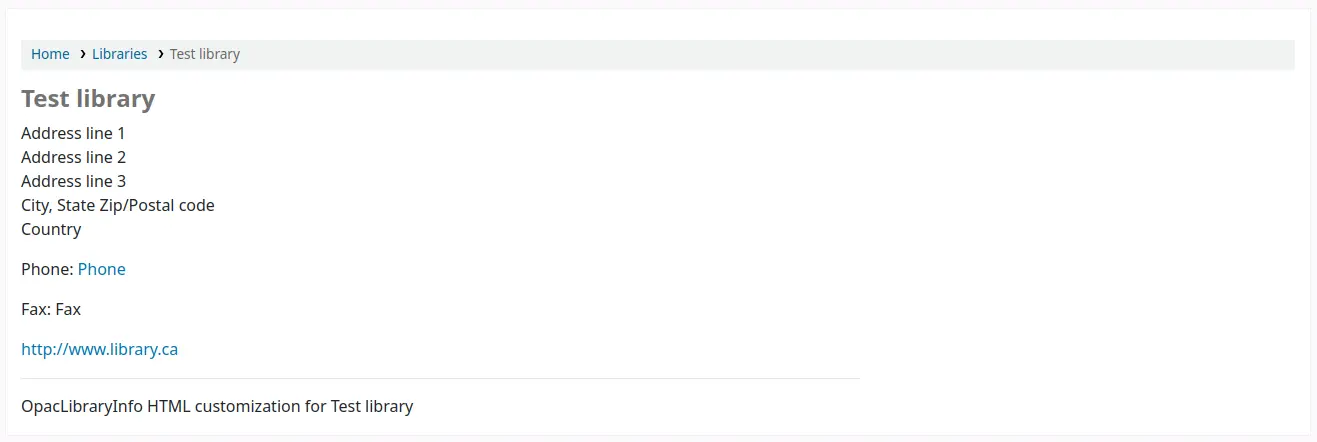
Reporting problems
If the OPACReportProblem system preference is enabled, patrons will have the option to report problems on the OPAC (broken links or inaccurate information for example).
At the bottom of each page is a “Report a problem” link.
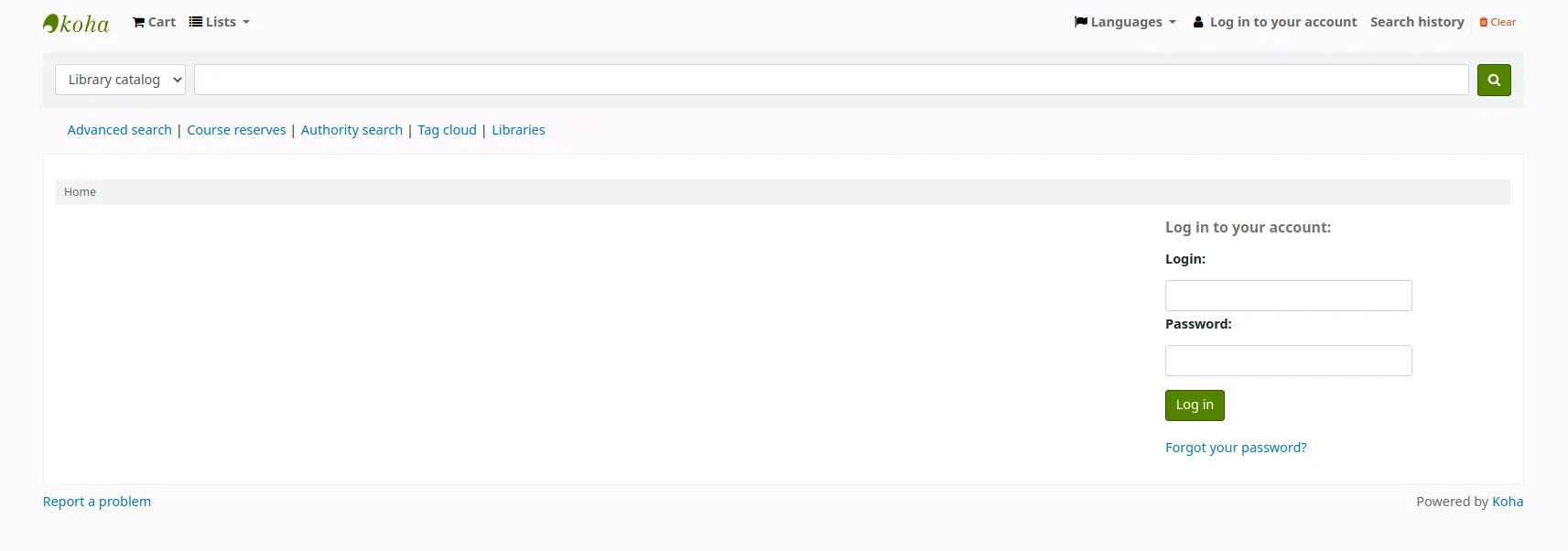
When the patron clicks on the link, they are brought to a form where they can specify what exactly is the problem.
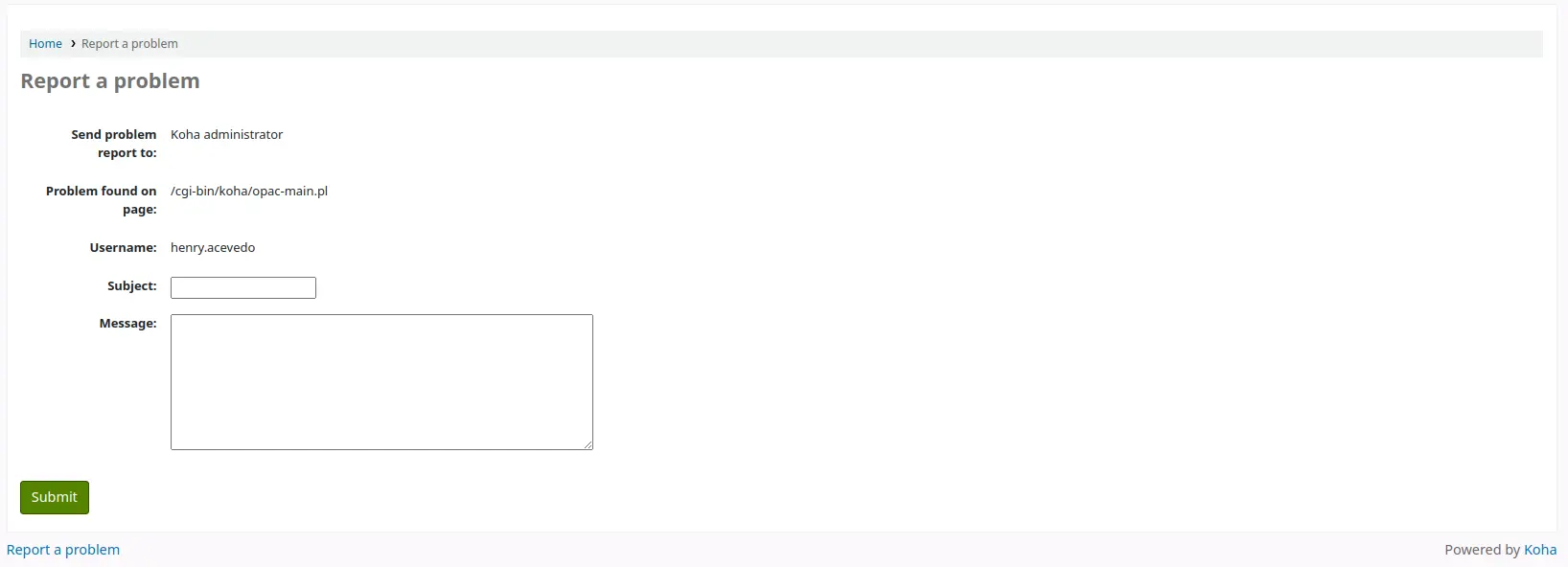
The problem report is sent to the Koha administrator by email (to the address in KohaAdminEmailAddress), and will appear in the OPAC problem reports tool. If the library has an email address, the patron will have the choice to either send the problem report to the library or to the administrator.
Nota
The notice sent by email is customizable in the Notices and slips tool. The letter code is PROBLEM_REPORT.
OPAC self checkout
Version
This feature was added in Koha version 23.11.
In addition to the self checkout module, there is a lighter weight option for libraries with smaller, trusted communities. With this option, patrons are allowed to check out items to themselves through their OPAC account with no oversight from library staff. This self checkout feature can be used on any computer or device with access to the OPAC, as opposed to the self checkout module which is meant to be used on dedicated computers.
Once the OpacTrustedCheckout system preference is enabled, logged in patrons will see a “Self checkout” option at the top of the page in the OPAC.

Clicking on the “Self checkout” link will open a pop-up where the patron can enter the item’s barcode and click “Submit” or press the enter key.
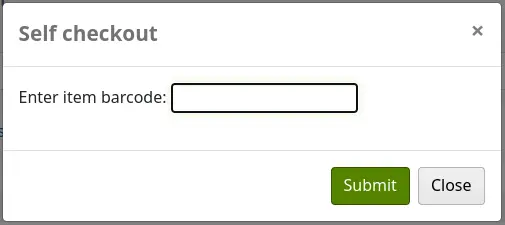
Once the item’s barcode has been entered, a confirmation message appears at the top of the pop-up and the item’s barcode, title, call number and due date are listed at the bottom. The patron has the option to scan or enter another barcode.
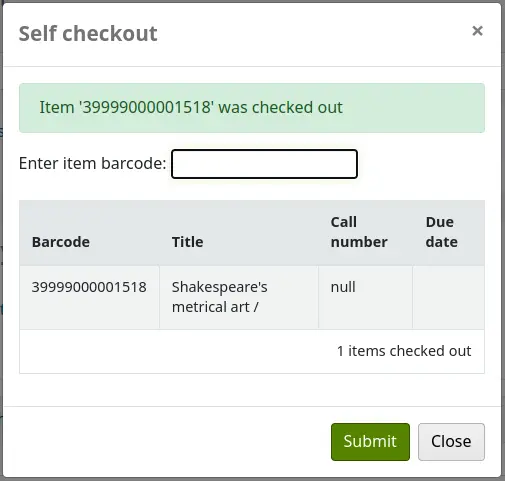
To renew the checkout, the patron only has to check out again (or renew from their summary).
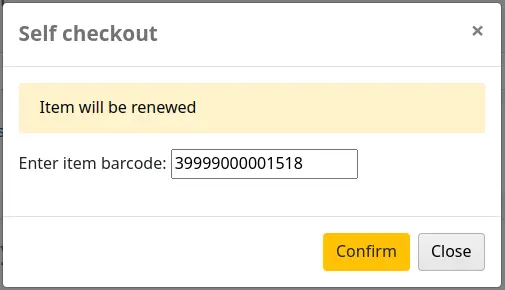
If an item is already checked out to another patron, a message will say so.

Checkout will also be blocked if:
the barcode is not found;
the item is on hold for another patron;
the patron’s outstanding charges are over the limit;
the patron already has the maximum amount of checkouts;
the patron does not have the required age to checkout the item;
the item cannot be checked out because of a not for loan or withdrawn status.
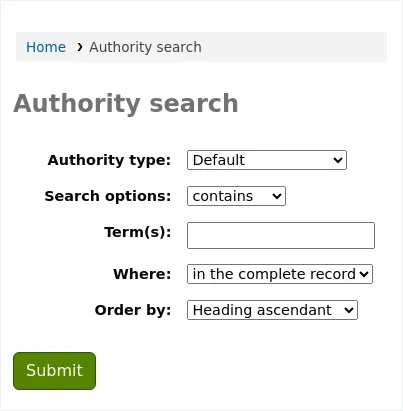


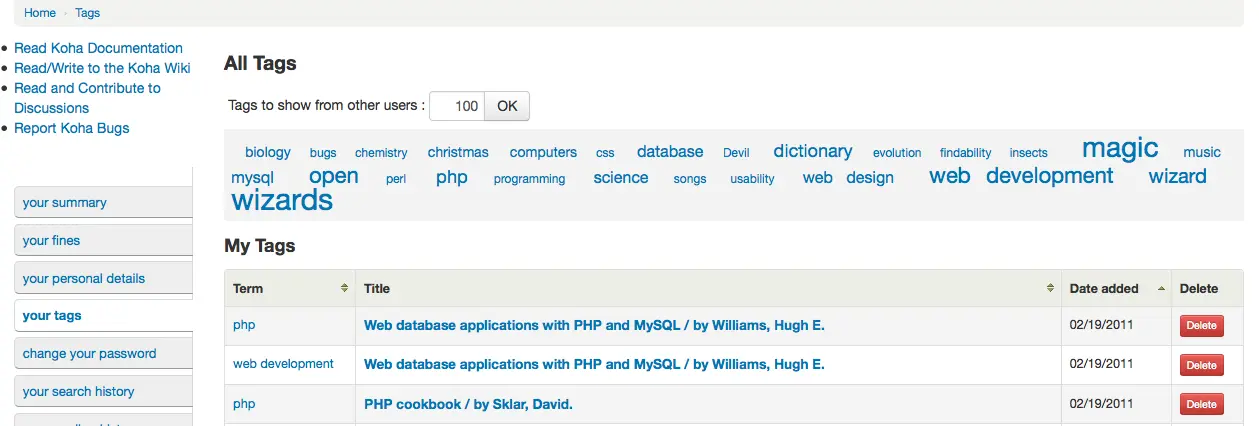
Commenti
Patrons can leave comments in the OPAC if you have the OPACComments preference set to allow this. Each bibliographic record has a comments tab below the bibliographic information.
Se l’utente è collegato vedrà un link per aggiungere un commento alla copia. Cliccando su questo link si apre una finestra pop-up con una casella di testo per i commenti.
Una volta che il commento è stato digitato e il inviato tramite il bottone “Invia”, l’utente vedrà il commento come in sospeso e altri utenti non vedranno il commento.
Once the comment is approved the patron will see the number of comments on the “Comments” tab and their comment labeled among the other comments. If the ShowReviewerPhoto system preference is set to “Show”, the patron’s photo pulled from the Libravatar library will be displayed next to their comment.
Other patrons will see the comment with the name of the patron who left the comment (unless you have set the ShowReviewer preference to not show patron names).
If you have your OpacShowRecentComments set to show then you’ll see the approved comments on that page.
Da questa pagina gli utenti possono ricevere i commenti recenti utilizzando il feed RSS.